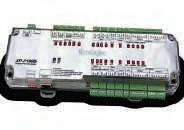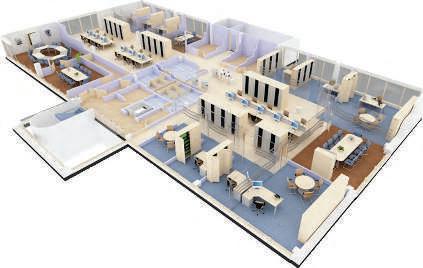


Sustainability In Concrete Structures










The mix development, “Damen” in USJ 1, Subang Jaya, Selangor Malaysia comprises of 2 levels Basement car park, 1 level semi underground car park, 1 block 6-storey shopping mall, 2 blocks 5 to 6 storey Shop Lots and 2 blocks 24 storey service apartment.
Approximately 20,000m³ of XYPEX Admix C-1000NF has been used to waterproof the Basement Slab, Retaining Wall, Lift Pit Walls and Water Tanks Walls, while approximately 6,500m² of XYPEX Concentrate & XYPEX Modiied have been applied to the Pile Caps. Xypex solutions were chosen for its ability to selfheal static hairline cracks up to 0.4mm wide, resist extreme hydrostatic pressure, and chemical protection, will contribute to enhance the durability, increase service life and reduce future maintenace costs of this structure very long into the future.
For more information on how our solutions can provide sustainable beneits for your concrete assets, please visit our website at www.xypex.com.au or LinkedIn Page.

Number 02, February 2015
IEM Registered on 1 May 1959
MAJLIS BAGI SESI 2014/2015 (IEM COUNCIL SESSION 2014/2015)
YANG DIPERTUA / PRESIDENT
Y.Bhg. Dato’ Ir. Lim Chow Hock
TIMBALAN YANG DIPERTUA / DEPUTY PRESIDENT
Ir. Tan Yean Chin
NAIB YANG DIPERTUA / VICE PRESIDENTS
Ir. P.E. Chong, Ir. Prof. Dr Wan Mahmood bin Wan Ab. Majid, Ir. Prof. Dr Lee Teang Shui, Ir. David Lai Kong Phooi, Y.Bhg. Dato Ir. Dr Andy Seo Kian Haw, Ir. Lee Weng Onn, Ir. Gopal Narian Kuty
SETIAUSAHA KEHORMAT / HONORARY SECRETARY
Ir. Gunasagaran a/l Kristnan
BENDAHARI KEHORMAT / HONORARY TREASURER
Ir. Prof. Dr Jefrey Chiang Choong Luin
BEKAS YANG DIPERTUA TERAKHIR / IMMEDIATE PAST PRESIDENT
Ir. Choo Kok Beng
BEKAS YANG DIPERTUA / PAST PRESIDENTS
Y.Bhg. Dato’ Ir. Pang Leong Hoon, Y.Bhg. Academician Tan Sri Dato’ Ir. (Dr) Hj. Ahmad
Zaidee bin Laidin, Y.Bhg. Dato’ Ir. Dr Gue See Sew, Y.Bhg. Datuk Ir. Prof. Dr Ow Chee Sheng, Y.Bhg. Academician Dato’ Ir. Prof. Dr Chuah Hean Teik
WAKIL AWAM / CIVIL REPRESENTATIVE
Ir. Prof. Dr Mohd. Zamin bin Jumaat
WAKIL MEKANIKAL / MECHANICAL REPRESENTATIVE
Ir. Dr Kannan M. Munisamy
WAKIL ELEKTRIK / ELECTRICAL REPRESENTATIVE
Ir. Ali Askar bin Sher Mohamad
WAKIL STRUKTUR / STRUCTURAL REPRESENTATIVE
Ir. Hooi Wing Chuen
WAKIL KIMIA / CHEMICAL REPRESENTATIVE
Ir. Prof. Dr Abdul Aziz bin Abdul Raman
WAKIL LAIN-LAIN DISPLIN / REPRESENTATIVE TO OTHER DISCIPLINES
Ir. S. Kumar a/l Subramaniam
WAKIL MULTIMEDIA / MULTIMEDIA REPRESENTATIVE
Engr. Abdul Fatah bin Mohd. Yaim, M.I.E.M. AHLI MAJLIS / COUNCIL MEMBERS
Ir. Lee Boon Chong, Ir. Tu Yong Eng, Ir. Lai Sze Ching, Ir. Yap Soon Hoe, Ir. Li Thang Fai, Ir. Juares Rizal bin Abd. Hamid, Ir. Norazman bin Mohamad Nor, Ir. Ellias bin Saidin, Ir. Assoc. Prof. Dr Jimmy Mok Vee Hoong, Ir. Dr Tan Chee Fai, Ir. Kok Hee Poh, Ir. Tiong Ngo Pu, Ir. Yau Chau Fong, Ir. Teh Piaw Ngi, Ir. Assoc. Prof. Ahmad Kamil bin Arshad, Ir. Kim Kek Seong, Ir. Chong Chin Meow, Ir. Chin Kuan Hwa, Ir. Assoc. Prof. Dr Vigna Kumaran Ramachandaramurthy, Ir. Lee Cheng Pay, Ir. Ong Ching Loon, Ir. Gary Lim Eng Hwa, Y.Bhg. Dato’ Ir. Noor Azmi bin Jaafar, Ir. Aminuddin bin Mohd. Baki, Ir. Mohd. Radzi bin Salleh, Ir. Ong Sang Woh
AHLI MAJLIS JEMPUTAN / INVITED COUNCIL MEMBERS
Dato’ Ir. Hj Hanapi bin Mohamad Noor, Datuk Ir. Rosaline Ganendra, Dato’ Ir. Abdul Rashid bin Maidin
PENGERUSI CAWANGAN / BRANCH CHAIRMAN
1. Pulau Pinang: Ir. Dr Mui Kai Yin
2. Selatan: Ir. Assoc. Prof. Hayai bini Abdullah
3. Perak: Ir. Dr Perumal Nallagownden
4. Kedah-Perlis: Ir. Chua Teik Seng
5. Negeri Sembilan: Ir. Shahrin Amri bin Jahari
6. Kelantan: Ir. Hj. Syed Abdul Rahman bin Syed Abdullah
7. Terengganu: Ir. Hj. Abdullah Zawawi bin Mohd. Nor
8. Melaka: Ir. Nur Fazil Noor Mohamed
9. Sarawak: Ir. Haidel Heli
10. Sabah: Ir. Tan Koh Yon
11. Miri: Ir. Steven Chin Hui Seng
12. Pahang: Ir. Tuan Haji Ahmad Kamal bin Kunji
AHLI JAWATANKUASA INFORMASI DAN PENERBITAN / STANDING COMMITTEE ON INFORMATION AND PUBLICATIONS 2014/2015
Pengerusi/Chairman: Ir. Prof. Dr Lee Teang Shui
Naib Pengerusi/Vice Chairman: Ir. Dr Tan Chee Fai Seiausaha/Secretary: Ir. Lau Tai Onn
Ketua Pengarang/Chief Editor: Ir. Prof. Dr Lee Teang Shui
Pengarang Bulein/Bullein Editor: Ir. Mohd. Khir Muhammad Pengarang Prinsipal Jurnal/Principal Journal Editor: Ir. Prof. Dr Dominic Foo Chwan Yee
Pengerusi Perpustakaan/Library Chairman: Ir. C.M.M. Aboobucker
Ahli-Ahli/Commitee Members: Y.Bhg. Datuk Ir. Prof. Dr Ow Chee Sheng, Engr. Abdul Fatah bin Mohamed Yaim, M.I.E.M., Ir. Dr Kannan a/l M. Munisamy, Ir. Siow Yun Tong, Ir. Chin Mee Poon, Ir. Yee Thien Seng, Ir. Tu Yong Eng, Ir. Ong Guan Hock, Engr. Aida Yazrin Mohd. Khairi, Engr. Kok Jing Shun
LEMBAGA PENGARANG/EDITORIAL BOARD 2014/2015
Ketua Pengarang/Chief Editor: Ir. Prof. Dr Lee Teang Shui
Pengarang Bulein/Bullein Editor: Ir. Mohd. Khir Muhammad Pengarang Jurnal/Journal Editor: Ir. Prof. Dr Dominic Foo Chwan Yee Ahli-ahli/Commitee Members: Ir. Dr Tan Chee Fai, Ir. Ong Guan Hock, Ir. Lau Tai Onn, Ir. Yee Thien Seng
IEM Secretariat: May Lee
Front Cover : Photo is courtesy of MMC Gamuda KVMRT (T) Sdn. Bhd.

COVER NOTE
KVMRT-The Game Changer
COVER STORY
Tunnelling & Underground Space Development in Malaysia 6 - 9
PRESIDENTIAL ADDRESS 2014
Challenging Engineers In National Economic Transformation Programme
FEATURE ARTICLES
Challenges in the Underground Space Development in the Urban Environment.........................................................14
Summary on Installation, Testing & Commissioning and Acceptance of Medical Device Guideline....................................18
Safety First, We Care...........................................23
PRESS STATEMENT & ERRATA 24 - 25
FORUMS
Half-Day Seminar: Inclinometer Measurements and Errors & Ground Anchors – From Design to Construction.........................................................26
Tunnel Boring and Other Underground Works of the KVMRT SBK Line............................28
CAFEO 32 in Yangon, Myanmar .........................30
Half-Day Seminar on Overview of Design & Construction of Deep Excavation & Tunnelling Projects in Singapore ..........................................36
One-Day Course on Introduction to LiDAR Survey Technology....................................38 26 - 41


Circulaion and Readership Proile ouresteemedreadershipconsistsofceriiedengineers,decision making corporate leaders, CEos, government oicials, project directors,entrepreneurs,projectconsultants,engineeringconsuling irmsandcompaniesinvolvedwithengineeringproductsandservices.
JURUTERA iscirculatedtomorethan 30,000 registered members ofTheInsituionofEngineers,Malaysia(IEM),withan esimated readership of 120,000 professionals.
Our business partners can be assured that their products and serviceswillbegiventhecirculaionandexposureitdeserves,thus maintainingasustainedadverisingpresencetoourcorereadersof decision-makingengineersandtechnicalexperts.ourwebsiteofers anevenwidermarketreach,withaddedinternaionalpresence,aided byourinternaionalailiaionwithoicialengineeringbodiesallover theworld.ouronlineandolineadverisingfeaturessuchasbanner adverising,ariclesponsorshipanddirecte-mailannouncements haveproventobesuccessfulmarkeingstrategiesthatwillsetthe businessesofourpartnersapartfromtheircompeiion.
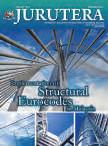



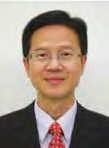
by Ir. Andrew Yeow Chairman of the Tunnelling and Underground Space Technical Division
When fully operational in Dec 2017, the Klang Valley Mass Rapid Transit (KVMRT) SBK Line from Sg Buloh to Kajang will be able to carry 400,000 commuters a day! Without doubt the KVMRT will be transformational as it changes the way people commute as well as create lots of regeneration opportunities to the neighbourhood and communities along the line.
With 31 stations, the 51km KVMRT SBK Line (Line 1) will connect KL city centre to Sg. Buloh, Kota Damansara, Cheras, Bandar Tun Hussein Onn and Kajang. This way, a commuter in Kajang can hop into the train, ride in comfort and, in less than an hour, go shopping in 1Utama or The Curve in Petaling Jaya! Another commuter can travel from Sg. Buloh to KL City centre in just 30 minutes, regardless of the trafic situation on the roads!
For the KVMRT project, there will be 9.5km of twin tunnels and 7 underground stations in the KL city centre. The need to overcome problems in tunnelling through the KL karstic limestone formation also resulted in the world’s irst Variable Density TBM, jointly developed by a German TBM manufacturer and Malaysian engineers.
This issue of JURUTERA is dedicated to the KVMRT with a focus on the construction of the tunnelling and underground works. It features several articles and activity reports related to tunnelling and underground space development/construction.
In addition, IEM will hold the International Conference & Exhibition on Tunnelling and Underground Space on 3rd - 5th March 2015, with eminent global speakers, particularly from the International Tunnelling Association (ITA). The ITA President will give the opening Keynote Lecture and the Executive Board Members will hold their meeting prior to the conference. IEM and ITA will also organise a 2-day workshop on tunnelling from 28th February, 2015 to 1st March, 2015.
DIMENSION PUBLISHING SDN. BHD. (449732-T)
level 18-01-03, PJX-hM Shah Tower, no. 16A, Persiaran Barat, 46050 Petaling Jaya, Selangor Darul Ehsan, Malaysia. Tel: +(603) 7493 1049 fax: +(603) 7493 1047 E-mail: info@dimensionpublishing.com Website: www.dimensionpublishing.com
for adverisement placements and subscripions, please contact: diMension publishing sdn. bhd. (449732-T) at +(603) 7493 1049, or E-mail: info@dimensionpublishing.com
Subscripion Department E-mail: subscripion@dimensionpublishing.com
Printed by
hoffset printing sdn. bhd. (667106-V) no. 1, Jalan TPK 1/6, Taman Perindustrian Kinrara, 47180 Puchong, Selangor Darul Ehsan, Malaysia. Tel: +(603) 8075 7222 fax: +(603) 8075 7333
Mailer
PERFECT MAIL SERVICES (648839-P)
14 Jalan TSB 2, Taman Perindustrian Sungai Buloh, Sungai Buloh, Selangor Darul Ehsan, Malaysia. Tel: +(603) 6156 5288
Jurutera Monthly CirCulation: 30,000 Copies
Submission or placement of aricles in JURUTERA could be made to the:Chief Editor
ThE InSTITUTIon of EngInEERS, MAlAySIA (IEM) Bangunan Ingenieur, lots 60 & 62, Jalan 52/4, P.o. Box 223 (Jalan Sultan), 46720 Petaling Jaya, Selangor. Tel: +(603) 7968 4001/4002 fax: +(603) 7957 7678
E-mail: pub@iem.org.my or sec@iem.org.my IEM Website: htp://www.myiem.org.my © 2015, The Insituion of Engineers, Malaysia (IEM) and Dimension Publishing Sdn. Bhd.
Chairman RoBERT MEBRUER CEO/Publisher PATRICK lEUng
General Manager ShIRlEy ThAM shirley@dimensionpublishing.com
Head of Markeing & Business Development JoSEPh hoW joseph@dimensionpublishing.com
Editor TAn BEE hong bee@dimensionpublishing.com
Contribuing Writers ARMAn PfoRDTEn & PUTRI ZAnInA pfordten@dimensionpublishing.com putri@dimensionpublishing.com
Senior Graphic Designer SUMAThI MAnoKARAn sumathi@dimensionpublishing.com
Graphic Designer nABEElA AhMAD beela@dimensionpublishing.com
AdverisingConsultants ABDUl AZIM BIn ShAARI&ThAM Choon KIT azim@dimensionpublishing.com ckit@dimensionpublishing.com
Accounts cum Admin Execuive yong yEn yIn yenyin@dimensionpublishing.com
publiCation disClaiMer
The publicaion has been compiled by both IEM and Dimension with great care and they disclaimanydutytoinvesigateanyproducts,process,services,designsandthelikewhichmay be described in this publicaion. The appearance of any informaion in this publicaion does notnecessarilyconsituteendorsementbyIEMandDimension.Thereisnoguaranteethatthe informaioninthis publicaionisfreefromerrors.IEMandDimensiondonotnecessarilyagree with the statement or the opinion expresssed in this publicaion.
Copyright JURUTERA Bullein of IEM is the oicial


TIr. Dr Ooi Teik Aun is the Founder Chairman of the IEM Tunnelling and Underground Space Technical Division and an Organizing Chairman of the International Conference & Exhibition 2015 (ICETUS2015. He is also the current Chairman of Dispute Resolution Practice (DRP) Subcommittee. He is an Advisor for Consulting Engineering Special Interest Group (CESIG). Ir. Dr Ooi is an Honorary Fellow of IEM, Fellow of the Malaysian Institute of Arbitrators and Past President and is ICE Country Representative for Malaysia. He is currently the Chairman of Dispute Resolution Practice (DRP) Sub-committee and an Advisor for Consulting Engineering Special Interest Group (CESIG). Ir. Dr Ooi is an Honorary Fellow of IEM, Fellow of the Malaysian Institute of Arbitrators, Past President, the ICE Country Representative for Malaysia and the President of Southeast Asia Geotechnical Society (2010-2016).
he development of tunnels and underground space in Malaysia has been slow due, perhaps, to the geology of Kuala Lumpur and the lack of know-how and conidence among the construction industry in tackling the problems presented by the Kuala Lumpur Limestone Formation.
But with the rapid development of tunnelling and ground improvement technologies in the last 30 years, this is set to change, especially with the active participation of the International Tunnelling Association (ITA) and the implementation of Line 1 of the Klang Valley Mass Rapid Transit (KVMRT) in 2012.
In July 1994, the Institution of Engineers, Malaysia (IEM) organised an International Conference cum Exhibition on Trenchless Construction – Towards Trenchless Cities. In February 2000, IEM also organised a seminar on Design, Construction, Operation And Other Aspects Of Tunnels. Prior to the seminar, the ITA held its executive committee meeting in Petaling Jaya, Selangor.
With the encouragement of ITA, the Tunnelling and Underground Space Technical Division (TUSTD) of IEM was
formed at the seminar and inaugurated in 2001 with the objective to undertake activities related to the promotion and advancement of the science and engineering of tunnels and underground space technologies. IEM TUSTD becomes a country member of ITA representing Malaysia. The irst and second International Conference and Exhibition on Tunnelling and Trenchless Technology were held in Malaysia in 2006 and 2011 respectively.
In 2003, construction of The Stormwater Management And Road Tunnel (SMART) in Kuala Lumpur, started. The storm drainage and road structure was aimed at solving the problems of repeated looding and trafic congestion in the business district of the city. The 9.7km tunnel is the longest stormwater tunnel in South East Asia and the second longest in Asia.
At the 2006 Conference, a special session was dedicated to papers from the SMART project which won the British Construction Industry International Award in 2008. In 2011, the SMART project received the UN Habitat Scroll of Honour Award for its innovative and unique management of storm water and peak hour trafic.
This year, IEM will again organise the third conference and exhibition on Tunnelling and Underground Space on 3rd - 5th March at Dorsett Grand Subang Hotel, Subang Jaya,Selangor.Thiseventcoincideswiththedevelopment of the massive Klang Valley Mass Rapid Transit (KVMRT) Line 1. Currently at construction stage, it is expected to be in an advanced stage of completion this year.

1. Cutting wheel
2. Excavation chamber
3. Face support medium
4. Submerged wall
5. Air bubble
6. Working chamber
7. Bulkhead
8. Feedline (LDSM)
9. Segment
10. Tailskin
11. Slurry line
12. Slurryier box
13. Suspension line (HDSM)
14. Communication pipes
15. Rotary crusher


We are pleased to inform that IEM will be holding the 56th Annual Dinner and Awards Night 2015 on 18 April 2015. Dimension Publishing has been appointed to put together the Annual Dinner Programme Book which will be circulated to all 1,200 guests on that night at Sime Darby Convention Centre
It is an annual event organised by IEM to present awards to winners of projects and at the same time to announce the new committee for year 2015/16. Special guests of honour will be invited to oficiate the event.
We are now calling for interested advertisers to book their preferred advertising position in this programme book. Below please ind the advertising rates for your immediate action and reply. We hope to hear from you soon before the closing date on 16 March 2015
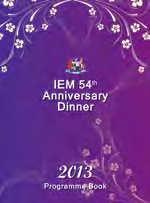

Book Size: 210mm(W) x 285mm(H). Please provide extra 6mm for bleed area on all 4 sides
Printing Speciications : 230gsm art card (Cover), 105gsm art paper (Text), 4C + 4C, Staple binding, UV varnish on Cover
Quantity: 1,200 copies
Advertisement Format : High resolution PDF ile, with crop marks, bleed area, text being outlined
Deadlines: : 16 March 2015 (Mon) (Ad Booking) 23 March 2015 (Mon) (Artwork Submission)
Kindly tick in the relevant bracket. IEM reserves the right to edit, revise or reject any advertisement deemed unsuitable or inappropriate. The inal print-ready artwork to be furnished by advertisers.
Company logo will be appeared in the Acknowledgement Page in both IEM Dinner Programme Book (1,200 copies) and JURUTERA May 2015 (30,000 copies)
Remarks:
• Space availability is subject to booking on irst-come-irst-served basis
• Advertising rate is subject to 6% GST. Please take note that the advertising rates shown above exclude the 6% GST
• Prices shown above exclude 15% Advertising Agency commission
• Any cancellation after signing the Advertising Contract shall result in a 50% penalty charge
• Payment term: 14 days upon invoicing
Name of Company:
Company Stamp & Authorized Signature:
Contact Person(s):
Date:
KVMRT Line 2 is currently in the detailed design stage for the elevated sections and construction work is expected to start in 2016, while the underground section is in tender stage. The conference will have 1 Opening Keynote Lecture, 3 Keynote Lectures, 5 Special Lectures, 1 Special Technical Session for KVMRT papers and other Technical Sessions consisting of 20 Technical Papers. The conference is endorsed by the International Tunnelling and Underground Space Association (ITA) and supported by Construction Industry Development Malaysia (CIDB), Mass Rapid Transit Corporation Sdn. Bhd. (MRT Corp) and The Institution of Civil Engineers (ICE), UK. It is sponsored by GamudaBerhad,ChinaRailwayEngineeringCorporation, Herrenknecht Asia Headquarters Pte. Ltd. and Sepakat Setia Perunding Sdn. Bhd.
Tunnelling activity is increasing all over the world and the last three decades have seen great advances being made in the construction of tunnels for various purposes. Malaysia is no exception, starting from the days of railway tunnels back in the 1900s. Tunnelling activity has been steadily increasing and tunnels are associated with water
supply and power generation from the 1960s. From 1970s, roads and highway tunnels were built.
By and large, these tunnels were constructed using drill and blast method. The use of TBMs in Malaysia started with the Sungei Kelinchi water transfer tunnel project in 1995 in Negeri Sembilan. The TBMs were also used in the 1990s in the Kuala Lumpur LRT tunnel construction and in sewerage projects in Kuala Lumpur.
WiththeexperiencegainedintheinnovativeuseofEPB Shield TBM technique in the SMART project to overcome the treacherous Kuala Lumpur Limestone Formation, the project team made further advances in TMB technology in the KVMRT project by using the Variable Density TBM (VDTBM).
It is understood that this innovation is the irst in the world. The mixed tunnel face is characterised by the simultaneouspresenceofsoftsoilandintactorfractured rock within the excavated cross-section. Excavations are carried out in karstic ground where fractured rock or mixed face conditions are often encountered in KVMRT.
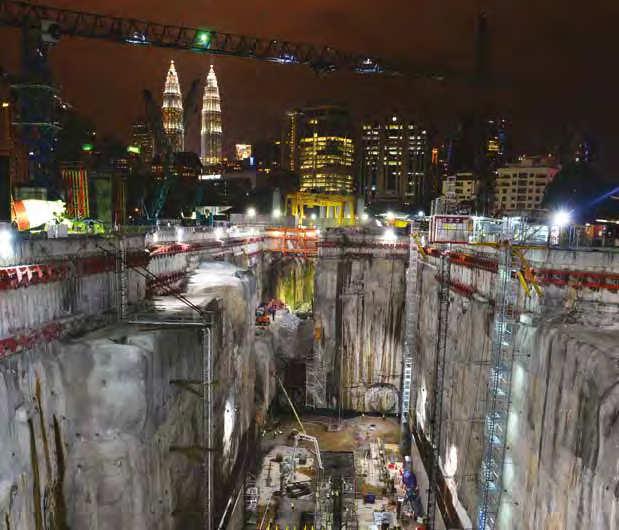
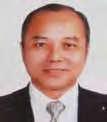
.Bhg. Dato’ Ir. Lim Chow Hock (林照福 ) was the Director of the Division of River Basin and Coastal Zone Management with the Department of Irrigation and Drainage Malaysia (JPS). He holds a B.Eng (Hons) (Civil) from the University of Malaya and a post graduate Diploma in Water Resources Engineering from the University of Birmingham.
PriortobeingelectedasthePresidentoftheInstitution,he servedIEMinvariouscapacitiesincludingasDeputyPresident, Vice President, Chairman of the Standing Committee on Finance,ChairmanoftheStanding CommitteeonCorporate Affairs, Deputy Chairman of the Standing Committee on Welfare and Service Matters and member of several other Standing Committees, Subcommittees and Technical Divisions. He also serves as the Chairman of the APEC/ International PE Registers. He was the Chairman of the IEM Southern Branch from 1991 to 1993.
Y.Bhg. Dato’ Ir. Lim has more than 35 years of experience in irrigation, agricultural drainage, lood mitigation, urban stormwater management, river engineering, coastal zone management,hydrologyandwaterresourcesmanagement. He has served in many States in various capacities throughout his career at JPS district, project, State and headquarters ofices. In his current role at JPS, he oversees
IamhonouredtobeelectedasthePresidentoftheInstitution of Engineers, Malaysia (IEM) for the 2014–2015 session and I thank the IEM Council for their vote of conidence. I will do my utmost for the Institution and the engineering fraternity at large.
I would not be at the helm of the Institution today, had it not been for the invaluable guidance of Past Presidents and Council Members. I am also indebted to fellow engineers and members who have shared their views and experiences with me.
I am fully cognisant of the responsibilities that lie before me.Itisachallengingtaskthatisbothexcitinganddaunting,
all programmes and initiatives associated with Integrated River Basin Management (IRBM) and Integrated Coastal Zone Management (ICZM); including major projects such as the River of Life Project, the Melaka River Beautiication Project, the Pahang River Mouth Breakwaters and the Tok Jembal Beach Nourishment Project in Terengganu. He is also responsible for all water management capacity building in MalaysiaespeciallyinrelationtoIntegratedWaterResources Management (IWRM).
He is the Chairman of the Malaysian Capacity Building Network (MyCBNet) and Member of several other professional associations including the Board of Engineers Malaysia, the Malaysian Institute of Management, the Malaysian National Committee on Irrigation and Drainage, the Malaysian Hydrological Society and the International Association for Hydro-Environment Engineering and Research. He is also an Exco member of the Malaysian Water Partnership. He is a Certiied Auditor with the Malaysia Register of Chartered Auditors (MRCA) and also a Certiied Professional in Erosion and Sediment Control (CPESC).
Y.Bhg. Dato’ Ir. Lim received the “Pingat Sultan Ismail” award from Johor in 2001. In 2008, he received the “Dato’ Paduka Setia Mahkota Kelantan” (D.P.S.K.) which carries the title “Dato” from His Majesty Al-Sultan of Kelantan.
one that will require the collaboration of each and every member of this Institution. I therefore ask for your fullest support and cooperation to assist me in not only maintaining the excellent tradition of this Institution but also making IEM even more relevant and recognised than it is today.
As President, I will embrace and continue with the good worksofourPastPresidents.Iwillalsotakestockofourstrength and weakness as well as to refocus and set the direction for the Institution. Allow me to share my thoughts on what I see as opportunities and challenges that lie ahead for us.
In 2010, the Prime Minister launched the Economic Transformation Programme (ETP) to spearhead Malaysia
towards becoming a developed nation, in line with Vision 2020. Realising the signiicant role that engineers must play in our national development agenda has prompted me to speak on “Challenging Engineers In National Economic Transformation Programme”.
In a highly globalised environment, Malaysia must adapt and seek solutions to the challenges posed by the changing social, economic and technological landscape.
The Government has given high priority to the social and economic development of the nation. Implicit in the strategies and action plans of the ETP is the strong commitment to leverage on engineering as the foundation for the necessary economic transformation. So to this end, engineers must take on an increasingly prominent role.
The ETP takes on new perspectives that are holistic, inclusive and sustainable, with social and environmental impact to be given due prominence. The approach to policy making and its implementation will see greater integration and co-ordination among the different authorities and agencies as well as greater partnership between government, private sector, civil society and non government organisations such as IEM.
The ETP represents the catalyst for economic growth and investments needed for us to achieve developed-nation and high-income status by 2020, with Gross National Income (GNI) per capita of RM48,000 or US$15,000 compared to RM23,700 or US$6,700 in 2009. This will be achieved by attracting RM1.4 trillion in investments which will, in turn, create 3.3 million new jobs by 2020.
WhiletheGovernmentwillplayafacilitatorroleinfunding theETP,theprivatesectorhasbeenplacedinthedriver’sseat and is expected to fund the bulk of the investments needed to implement the projects drawn up in the ETP. It is envisaged that, in terms of the overall funding, 60% will come from the private sector, 32% from the Government Linked Companies (GLC) and the remaining 8% from the public sector.
The ETP will be achieved through the implementation of 12 National Key Economic Areas (NKEAs), representing economicsectorswhichaccountforsigniicantcontributions to Gross National Income (GNI) and which can create multiplier effects across the national economy. Each NKEA will have various Entry Point Projects (EPPs), which are new growth programmes with high economic impact for moving the sector up the value chain.
The ETP is also centred on raising Malaysia’s competitiveness through the implementation of six Strategic Reform Initiatives (SRIs). These comprise policies which will strengthen the country’s commercial environment to ensure that Malaysian companies are globally competitive and sustainable.
The ETP is heavily dependent on advanced engineering knowledge and specialised skills to deliver most if not all of theEntryPointProjectsidentiiedundertherespectiveNKEAs.
Engineering based activities dominate in 11 of 12 NKEAs, directly or indirectly, and provide substantial business and employment opportunities. The oil, gas and energy sector, for example, will see 50,000 new jobs with about 40% for professionals such as engineers of various disciplines.
Extensive infrastructure build-up, particularly in the areas of broadband and logistics, is necessary to support the communications, content and infrastructure sector. The penetration rate for broadband is targeted to reach 75 percent of households by the end of 2015 from the current 40 percent. Infrastructure such as roads, ports and airports are being upgraded and major projects in the pipeline include the new West Coast Highway, the extension of the north–south electriied double-track railway line to Johor Bahru and the Kuantan Port expansion.
The urban populationwill grow from 64 percent to 70 percent, mostly in the Greater Kuala Lumpur-Klang Valley (KL-KV) where there will be a continuous demand for infrastructure projects to cope with the increase. Among the most ambitious projects are the River Of Life, which will see the cleaning, beautiication and re-development of the Klang and Gombak Rivers, the Mass Rapid Transit system and the proposed high-speed rail system from Kuala Lumpur to Singapore. Extensive growth is also taking place in Penang and the Iskandar Region.
Education is one of the most critical drivers for transformation. The strategy is to rebrand Malaysia from a stopover location for education to a major education centre of choice globally. As the private education sector is expected to grow six-fold, an additional 500,000 jobs will be created, especially in professional and technical ields.
The structure of our economy will have to be transformed. Liberalisation measures are being put in place to expand the potential market of the country beyond national boundaries, intensify competitiveness, as well as attract foreign investments. The economy will become less dependent on resource-intensive industries and will instead, be driven more by innovation and a shift to higher valueadded activities.
The services industries in particular, will become more crucial and is estimated to increase to 65 percent of the Gross Domestic Product by the year 2020.
TheETPdependsonanewparadigmshiftthatdemandsnew waysofthinking,newskillsandcapabilitiesandnewmethods of doing things. There will be a need for innovation, for entrepreneurship, for business acumen, good management ability, a global perspective and multi-disciplinary skills to meet the challenges set by the ETP and will demand no less than a major transformation of the engineer.
Engineers are trained to solve problems and to build things which form a strong foundation for innovation but that is not enough. They will need to think “out-of-the-box”, to view things in a different perspective and to challenge the norm.
Innovation brings about new ideas but creating value from these new ideas will require skills to translate them into

successful businesses. Engineers already have the analytical and problem solving abilities but they will need to augment those abilities with soft skills and business knowledge such as inance, marketing, and sales.
With society becoming more complex and engineering jobsbecomingmorediverse,itwillbenecessaryforengineers from different disciplines to work together. They can expect to work more with experts from other ields such as scientists, economists, planners, politicians, business and community leadersandothers.Technicalknowledgealonewillnolonger sufice; engineers will need to know about social sciences, the arts and commerce to get a more holistic view of how things can be done.
IEM has a role to ensure that the education, training and qualifying standard for professional engineers is on par with the best in the world. It must also ensure a suficient pool of competent technical personnel to meet demand. Already, IEM has initiated the Structured Training Program to provide an alternative path for engineers to meet the requirements of practical experience when they do not have the opportunities at their work place.
To complement the Government’s effort to increase local talent, both in quantity and quality, IEM already has several Continue Professional Development (CPD) programmes, aimed at upgrading the knowledge and skills of the engineers in the ever-changing technological landscape. In view of this, I shall ensure that all CPD programmes are continuously reviewed, revised and upgraded to the standards to suit the current needs of the nation, in particular the ETP. The Institution shall identify new training areas and focus on priority sectors that can support the ETP, based on regional needs.
As innovation is a key success factor in the ETP, IEM shall work closely with the Ministry of Science, Technology and Innovation (MOSTI), institutions of higher learning and other engineering research organisations to conduct necessary complementary courses related to innovation, standards and accreditation.
We must produce engineers who are relevant to the needs of the industries and the public sector. In this respect, IEM shall complement the Government’s effort to educate students in schools on what engineers actually do and to assist universities develop an engineering education curriculum that is more practical, relevant and interesting.
The Performance Management & Delivery Unit (PEMANDU) under the Prime Minister’s Department, was established in 2009 to plan, oversee the implementation, and assess the progress and impact of the ETP. Since the bulk of the Entry Point Projects (ETPs) of most NKEAs are engineering based, it is pertinent that IEM re-establishes a strong link with PEMANDU.
For its view to be heard and considered, IEM must engage proactively with the Government at all levels by offering expert advice on matters related to engineering.
IEM must be seen as the most relevant body to be invited by the Government to give professional engineering input at every stage, especially during policy formulation of all our national socio-economic development programmes. I shall actively liaise with all relevant Government authorities, including local authorities, for IEM to be represented in the appropriate decision-making bodies or committees. In a similar vein, IEM must position itself to respond to such invitations in the most effective and timely manner.
IEM must also work closely with various related statutory bodies such as the Board of Engineers Malaysia (BEM), the Construction and Industry Development Board (CIDB), the Energy Commission, the Malaysian Communication and Multimedia Commission, etc. to provide the necessary synergy towards nation development.
To be an effective voice of the profession, IEM must be able to reach out to the public through the media, particularly the print and electronic media. For that to happen, IEM must have a good database of relevant engineering information and position papers on all major engineering issues which deine the views and stands of the Institution. It must also have in place, members with the expertise and credibility to provide the necessary input in preparing Press statements on behalf of the Institution.
I will continue to engage actively with the media to project the image of IEM as the professional organisation collaborating with the Government to tackle the nation’s engineering issues. IEM must fulil one of its most important primary roles: To shape the practice of engineering, to protect the interests of engineers and the public at large, and to contribute to the success of nation development.
With the impending liberalisation of trade within ASEAN, APEC and across the world, the engineering community must be ready to work in a borderless environment where competition intensiies and opportunities abound. Engineers must adopt a global outlook as potential clients, partners and competitors will come from all corners of the world. I shall follow up closely on current efforts taken by the Institution in collaborating with the Ministry of International Trade and Industry (MITI) to promote the export of engineering services in the global market.
IEM must fully support the ETP and engineers must seize the opportunities available and rise to the challenges. There must be active engagement with PEMANDU and all relevant Government authorities, statutory bodies, related business communities, the media and the public.
I implore members to participate actively in all engineering related issues in society so that our expert views and contributions will be appreciated and acknowledged.
Last but not least, I envisage an enlarged IEM with the continuation of Vision 100K in order to have more clout, a louder voice and stronger leverage to enable us to champion the advancement of the engineering profession.

By Ir. Dr Ooi Teik Aun
Ir. Dr Ooi Teik Aun is the Founder Chairman of the IEM Tunnelling and Underground Space Technical Division and an Organizing Chairman of the International Conference & Exhibition 2015 (ICETUS2015. He is also the current Chairman of Dispute Resolution Practice (DRP) Subcommittee. He is an Advisor for Consulting Engineering Special Interest Group (CESIG). Ir. Dr Ooi is an Honorary Fellow of IEM, Fellow of the Malaysian Institute of Arbitrators and Past President and is ICE Country Representative for Malaysia. He is President of Southeast Asia Geotechnical Society (2010-2016).
Part of the Kuala Lumpur City Centre (KLCC), the Petronas Twin Towers building is located in the contact zone of the Kuala Lumpur limestone and Kenny Hill formation.
Kuala Lumpur limestone formation is characterised by subsurface karstic features consisting of pinnacles, solution channels, cavities, overhangs and loaters. The Kenny Hill formation comprises a series of interbedded shale,phyllite,sandstoneandquartzite.Ooi,T.A. (1986) discussed the design and construction problems of foundation for highrise structures in the Kuala Lumpur area at that time.
Bored piles and barrette piles were used as the foundation for Pan Paciic Hotel, Putra World Trade Centre and the Mall. It is common practice to install a diaphragm wall or contiguous bored pile wall at the boundaries of the sites. These walls are constructed prior to excavation work being carried out.
In the KLCC Petronas Twin Towers, 20m excavation was made for the basement car park in Kenny Hill Formation. Ooi et al., (2013) reported a recent mixed development of approximately 9ha (22acres) in the southern
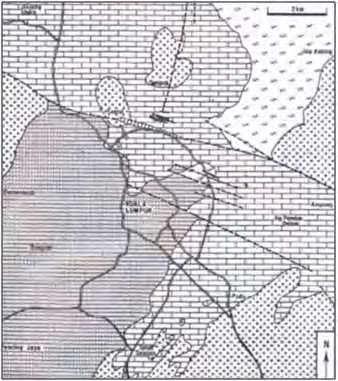
region of Kuala Lumpur city where the site is located in variable quality of limestone formation. The development (known as Velocity) is divided into 3 phases with Phase 1A having limestone bedrock from 3m to 45m below ground level.
The site is bounded by the Cochrane and Maluri Klang Valley Mass Rapid Transit (KVMRT) stations. The quality of limestone bedrock at the shallow part of the site has average RQD (rock quality designation) of 0 percent and 70 percent while that of the deep part has average RQD of 0 percent to 80 percent. The Unconined Compressive Strength (UCS) of the limestone below the basement 3 level varies from 20 MPa to 80 MPa. Contiguous Bored Pile (CBP) walls were used at the north and south sides of the site. The length of the CBP wall varies from 13.5m to 24m below ground level.
Open cut method was adopted on the east and west side to the basement 3 level with a slope height of 13m. No ground water was encountered during the construction of the basement even though at the time of site investigation, monitoring indicated ground water at 1-2m below ground level. The building consists of one 18-storey service apartment and one block of 13-storey shop ofice. Raft foundation was used for 3 level of basement built on excavated sound limestone outcrop while bored piles were used for those areas with limestone outcrop in a deeper part of the site.
In the KVMRT underground stations, Goh et al., (2015) discussed an overview of the construction of the Maluri MRT Underground Station by MMC-Gamuda since May 2012, outlining strategies for the successful management and mitigation of the challenges of safely incorporating an underground station into the substrata of a densely populated urban centre predisposed towards gridlocked trafic conditions and located in direct proximity to established residential properties and active
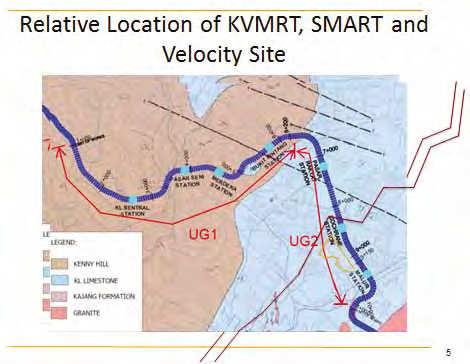
retail business premises. The project design, from the ground up, focused on pragmatic, usable connectivity on three fronts, namely for pedestrians, private vehicle access and connectivity to public transport networks.
In addition to project design, the scope of engineering works included a systematically sequenced roll-out, beginning with relocation of underground civil utilities serving the existing built environment, trafic mitigation through staged trafic diversion retaining full unimpeded use of six fast-lowing trafic lanes, construction of underground station including activities such as ground treatment, secant pile wall installation, strutting, decking, rock blasting and miscellaneous works, concurrent with installation of steel decking as an expedient to allow heavy trafic low to continue directly over the station excavation and construction works area and ending with inal reconstruction of the road surface and completion of pedestrian access infrastructure.
The total time allowed for the construction of Maluri MRT Underground Station was 60 months. Amberg &

Cornaro (2012) discussed the use of underground space for the sustainable transformation of urban infrastructures. It concluded that using the underground space strategically could contribute to the sustainability of cities in a major way. It suggested some examples of various uses that had helped to create more liveable cities by placing transport, utilities and other “land consumers and polluters” underground, thereby freeing up valuable surface space and leaving space for more amenable uses to urban life above ground. Underground space should be considered a crucial layer in urban spatial planning and land use in the bid to accommodate an additional 3 billion global population in urban environments in the next few decades.
In accommodating the increased associated trafic and congestion in urban areas, in reducing the pollution from transport, industrial or production facilities, in securing our drinking water supply and recycling waste water, in protecting us and our cities and infrastructures from natural disasters, we are reaching the conclusion that the use of underground space will be an important component for improving overall urban qualities and towards a sustainable transformation of urban infrastructures. Kuala Lumpur has the advantage of learning from others at this stage.
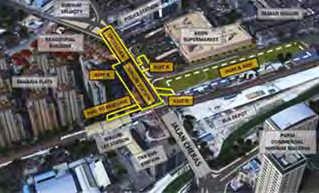

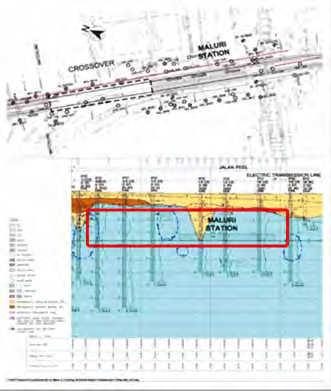

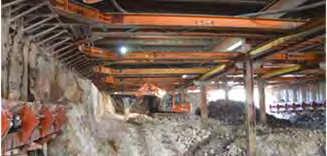

[1] Amberg, F. & Cornaro, A. (2012) “Underground space for the sustainable transformation of urban infrastructures” 2nd International Green Workshop & Exhibition on Sustainable Infrastructures and buildings “Towards Zero Carbon Footprint”, 30 - 31 Oct 2012 IEM Kuala Lumpur, Malaysia. Keynote Lecture 4 pp1-7.
[2] C.Y. Goh, Y.S. Lim and K.C. Ong (2015) “Challenges of a Deep Excavation at an Urban Area” Proceedings of the International Conference & Exhibition on Tunnelling & Underground Space (ICETUS2015) 2-5 March 2015 IEM, Kuala Lumpur, Malaysia (to be published).
[3] Ooi,T.A.(1986)“DesignandConstructionProblemsofFoundationforHighrise Structures in the Kuala Lumpur Areas” Proceedings of IEM-JSSMFE Joint Symposium on Geotechnical Problem, Kuala Lumpur, Malaysia pp112-122.
[4] T.A.Ooi,Y.G.Tan&V.W.Pong(2013)“InstrumentedBoredPileinCavernous Limestone Formation in Southern Region of Kuala Lumpur” Advances in Geotechnical Infrastructure Edited by C. F. Leung, S. H. Goh & R. F. Shendoi; 2013 Geotechnical Society of Singapore (GeoSS). Published by Research Publishing. ISBN: 978-981-07-4948-4:10.3850/978-981-07-4948-4 082.
Title: 2-Day International Seminar and Workshop on Presentation and reviewing of the Draft Malaysian N.A. for EC8
9th feb 2015 - 10th feb 2015
Organised by : Civil and Structural Engineering Technical Division
Time : 9.00 a.m. - 5.30 p.m.
CPD/PDP : 13
Kindly note that the scheduled events below are subject to change. Please visit the IEM website at www.myiem.org.my for more information on the upcoming events.


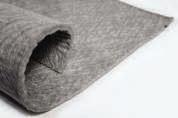
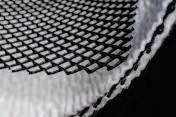

By Ir. Dr Syed Mustafa
Ir. Dr Syed Mustafa Kamal Bin Syed Aman is the Deputy Director (Biomedical) of Engineering Services Department, Ministry of Health Malaysia, Putrajaya. He obtained a B.Sc.(Hons) in Electrical (Electronics) Engineering (University of Aberdeen, U.K) and M.SC. in Biomedical Instrumentation Engineering (University of Dundee, U.K) and Ph.D. in Biomedical Physics (University of Exeter, U.K). He has worked as an Electronics/ Biomedical Engineer for more than 28 years and certiied as PE in the ield of Biomedical. He is a member of IFHE, BEM, IEM, EAC, BEAM, MEAM and as industry advisor to UTM, MMU, UNIKL, UTHM, KKTM, PSA. He is very active in developing standards and guidelines for SIRIM, DSM and MDA. His areas of interests are in Management of Active Medical Devices, Ionizing and non-ionizing Medical Radiation, Functional Magnetic Resonance Imaging (fMRI) and touch perceptions (http://www. centres.exeter.ac.uk/ pmrrc/individual/syed. html).
This guideline has been prepared under Medical Device Bureau Technical Committee, Ministry of Health Malaysia, with the intention to provide guidance to ensure the medical device is appropriately installed, tested and commissioned by the equipment specialists or competent personnel and accepted in accordance with manufacturer’s speciication, purchase agreement and statutory requirement.
The guideline applies to all products that fall within the deinition of a medical device, as deined in Medical Device Act 7372012 and applies to all medical devices which require installation, testing and commissioning (T&C) and acceptance in healthcare facility, aesthetic settings and premises for wellness programmes as well as related services.
For a newly purchased medicaldevice,themedical device establishment (i.e. vendor or supplier) shall be responsible for carrying out the installation and T&C of the medical device while the medical device owner (i.e. hospital, clinic, etc.) shall be responsible for the acceptance processes of the medical device.
Medical devices which are leased or on loan, trial evaluation and clinical investigation, transferred and undergone major upgrading, shall also be installed, tested and commissioned before use.
(Refer to lowchart
Figure 1).
Figure 1: Flowchart of testing & commissioning and acceptance of medical device
In any purchase of a new active medical device, documentation shall be made available to medical device owner by the medical device establishment prior to T&C. Example of documents are: Device registration certiicate, Establishment Licence from Medical Device Authority (MDA), purchase agreement, relevant licences, test certiicates, manuals (user/operation/service/maintenance) and build drawing of site and facility where relevant.
The medical device establishment shall provide written notiication of any speciic installation and T&C requirements to the medical device buyer.
Apart from new purchases, medical devices on lease, loan, trial evaluation, clinical investigation, transfers, donationsandthosethathaveundergonemajorupgrading, documentation shall also include maintenance history, a clear statement that the equipment is being resold or donated and proof of decontamination.
For a designated medical device, all drawings, safety requirements and installation plan shall be submitted for approval to the relevant regulatory authority. For management of radioactive source, the medical device owner shall refer to the medical device establishment and regulatory authority.
For non-active medical devices, only inspection, training and acceptance procedure are required.
Medicaldevicesarecategorisedintoactivemedicaldevice and non-active medical devices. Active medical device refers to any medical device, operation of which depends on a source of electrical energy or any source of power other than that directly generated by the human body or gravity and which acts by converting this energy.
Medical devices intended to transmit energy, substance or other elements between an active medical device and thepatient,withoutanysigniicantchange,isnotconsidered active medical device.
a. For active medical device that requires installation Installation usually applies when any of the following occurs:
1. Substantial assembly work will be required on-site;
2. There are dedicated plumbing, electrical and gas pipeline connections for the equipment
3. The device needs to be permanently ixed in place.
The medical device owner, with medical device establishment input or advice, shall ensure site preparation is inaccordancetomanufacturerandregulatoryrequirement. The medical device owner shall ensure that all technical drawings (medical device layout, mechanical and electrical, civil and structural) are submitted to the relevant authorities or departments for approval prior to installation. Professional, competent technical personnel shall endorse the medical device installation layout. The medical device establishment shall install the medical device in
accordance to the manufacturer’s technical speciication for installation work. All as-built drawings shall be made available and submitted to competent technical personnel of the medical device owner.
b. For active medical device which does not require installation
The medical device owner, with medical device establishment input or advice, shall perform a pre-check priortoT&C.Thepre-checkincludesavailabilityandsuficient utility such as medical gas, electrical supply (essential/nonessential), water supply, appropriate placement area i.e.; ventilation, humidity, room temperature.
a. Renovation
The medical device owner shall furnish the details of the renovation scope of work and a room data sheet recommended by medical device establishment. A room data sheet provides information on the minimum requirements for the room where the medical device is to be installed. The medical device owner shall prepare shop drawings that include:
1. Architectural drawings;
2. Structuredrawingendorsedbytheprofessionalengineer ifrequired
3. Layout and positioning details of the medical device and related systems as recommended by the establishment and local statutory and regulatory requirement and
4. Utilities details to support the installation of medical device andcorrespondingassociateddrawing.
Priortoinstallation,allshopdrawingsrelatedtotheinstallation of the medical device shall be veriied by professional, competent technical personnel and agreed to by the medical device owner.
The medical device owner shall carry out the renovation and site preparation works according to the approved scope of work and shop drawings. Competent technical personnel shall supervise the renovation and site preparation works.
b. New building/ new building extension
Ifanewbuildingornewextensionbuildingistobeconstructed to accommodate the new medical device, the medical device owner shall appoint a team of consultants consisting of architects, civil and structural engineers, mechanical and electrical engineers, quantity surveyor and medical device planner. The consultants should be registered with their respective professional boards or other relevant bodies.
c. Mobile Healthcare Facilities
Mobile healthcare is a service that is provided on ixed routes and at a number of points, which are visited on a regular basis. Some visiting points may involve the use of a room in a building but the resources (equipment, stocks) are provided from the mobile when the service is available and are not maintained at the visiting point. The medical device
owner shall submit a technical report on the suitability of the proposed vehicle to the Road Transport Department.
The medical device owner shall prepare relevant document that includes drawings giving details of retroitting works, layout and positioning details of the medical device and related systems, safety features and utilities details such as cold water supply, treated water supply, electrical supply, steam supply, medical gases and drain. The relevant authority shall approve all drawings.
The mobile medical device owner shall carry out the vehicle renovation and site preparation works according to the approved scope of work and drawings. Appointed consultants and competent technical personnel shall supervise the renovation/site preparation works.
Site preparation works for the installation of the medical device shall be ready prior to installation. Competent technical personnel appointed by the medical device owner shall verify all relevant documents prior to device installation and ensure the facility is ready prior to installation. They will also ensure that the installation complies with the manufacturer’s instructions and that all safety requirements are as required by the manufacturer and relevant authority. The medical device establishment shall ensure only equipment specialist(s) will carry out the installation.
The medical device establishment shall produce the manufacturer’s calibration certiicate or report for any medical device that does not require on-site calibration. The medical device establishment shall perform the calibration as per manufacturer’s speciication for any medical device that requires on-site calibration. A recognised and certiied calibration laboratory shall do this for any medical device that requires certiied calibration. The medical device establishment shall submit the calibration test report and calibration certiicate of the medical device to the medical deviceowner.Themedicaldeviceestablishmentshallrectify all faults that can cause calibration to fail and re-perform the calibration until it passes.
Themedicaldeviceownershallverifythatthemedicaldevice delivered is in good condition and complete, based on the purchase document. Physical evaluation or visual checks of the medical equipment include observations of chassis, mount/fasteners, castor/brakes, power cord, connectors, control/ switches, indicators/displays, accessories and labeling. T&C is best performed at the very location where the medical equipment will be placed for use.
The medical device establishment shall operate the medical device to ensure it is functional and ready to be tested. The competent technical personnel of the medical device owner shall ensure that all required documents are made available during T&C by the medical device establishment,suchasacopyofdeliverynote(whichspecify separately between main system, subsystems, accessories and consumables), certiicates, calibration report, manuals and backup copy of software, declaration of previous
recalls/device alerts/end of life date, quality assurance, service engineer training certiicate (manufacturer training), response time during warranty period and tentative date for equipment and technical training.
The medical device establishment is required to perform speciic tasks during T&C on the medical device. These include conirmation of items delivered based on purchase document, validation of the speciication/parameters using appropriate test equipment and all other relevant safety tests to the equipment which shall also be conducted and recorded accordingly.
The equipment specialist from the medical device establishmentshallcarryoutperformanceandsafetytestsas required by the manufacturer, and witnessed by competent technical personnel.
A label indicating that the medical device has passed the electrical safety test, shall be afixed at a visible area on the device. All results shall be documented and the medical device establishment shall keep all documents according to retention period as speciied by MDA. A copy is to be submitted to the medical device owner.
T&C shall be repeated upon rectiication of all deiciencies by medical device establishment.
The medical device owner accepting the device has the discretion to determine when and where the device should be inspected and sampled for conformance to speciications, depending upon the risk that failure of that device may pose. The non-active medical device shall be inspected by the medical device establishment, medical device owner (material/procurement warehouse) and medical device owner (user).
The medical device owner shall perform general acceptance inspection on random sampling basis for the non-active medical device against the purchase order. Inspection tasks shall include but not be limited to:
1. Checking and verifying that the product is exactly as ordered and corresponds with the delivery note
2. Veriication of quantity, size, consumable items and accessories delivered as stated in the purchase agreement
3. Visual inspection of the device or equipment for physical damage, incompleteness, misassembling, void, wear and/ or abuse
4. Check relevant labelling on the device
5. Take note of batch number or lots in the event of a product recall
6. Contamination
7. Disseminate instructions and safety information when necessary.
Rejected medical devices shall be documented, rectiied or replaced by the medical device establishment. The medical device establishment shall provide proof of compliance to the speciication in purchase document and the medical device owner shall keep records of inspection.
The medical device establishment shall issue a T&C certiicate once the T&C process is successfully completed. The medical device establishment, medical device owner and competent technical personnel shall sign the T&C certiicate.
EqUiPMENt tRAiNiNg
Themedicaldeviceestablishmentshallprovideon-site,hands-onequipment training. The equipment training module shall include but not be limited to:
a) Safety precautions in operating the medical device
b) Proper operation/application
c) User maintenance
d) Cleanliness and decontamination
e) Operational veriication procedures
f) Recognition and correction of common operational problems
g) Recognition of defective equipment and potential hazards
h) The risk associated with the device.
The medical device establishment shall issue a certiicate of attendance to the user upon completion of the training.
tECHNiCAL tRAiNiNg
The medical device establishment shall conduct on-site technical training to the competent technical personnel of the medical device owner during and after the T&C. A certiicate of attendance shall be issued upon completion of the training.
For the recognition of technical competency on that particular medical device, the medical device establishment shall offer detailed technical training according to maintenance competency level, with a reasonable fee. The medical device establishment shall issue a certiicate of competency to the competent technical personnel upon completion of the training. The detailed technical training module shall include equipment training module and other module but not be limited to:
a) PPM according to manufacturers’ speciication
b) Maintenance competency as deined by MDA.
The medical device establishment shall issue a certiicate of competency to the competent technical personnel upon completion of the training.
NoN-ACtivE MEDiCAL DEviCE
Non-active medical device is accepted upon completion of successful inspection and training. The medical device establishment and medical device owner shall sign the records of acceptance.
ACtivE MEDiCAL DEviCE
Competent technical personnel shall perform the tasks that include, but not be limited to:
a) Ensuring the medical device is exactly as ordered and corresponds with the delivery note
b) Verifying the quantity, consumable item and accessories delivered as stated in the purchase agreement
c) Ensuring the equipment has successfully undergone performance and safety tests
d) Checking of relevant labelling on the device
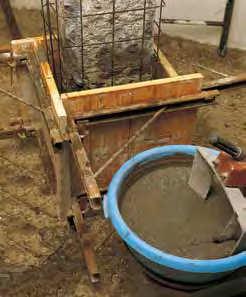




e) Ensuring the medical device is delivered with a full set of documentation including user and operating manuals, spare parts list, schematic diagram,PPMmanualandchecklistasrecommendedbymanufacturer,

validated T&C report and certiicate, calibration certiicate, training certiicate and any other relevant document
f) Ensuring the medical device technical support information from the medical device establishment is submitted (address, person in-charge, telephone number, fax number, medical device registration number and any relevant information)
g) Ensuring the user and technical training on the medical device has been carried out.
Upon passing the acceptance testing, the medical device shall be labelled to indicate asset identiication, warranty information, performance test pass label, electrical safety pass label (where applicable) and next PPM due date.
The medical device establishment shall issue an acceptance certiicate once the acceptance process is successfully completed. The medical device establishment, medical device owner and competent technical personnel shall sign the certiicate. The warranty period and PPM frequency (within the warrantyperiod)shallbespeciiedintheacceptancecertiicate.
This guideline aims to lay down the minimum installation, testing and commissioning and acceptance requirements to be carried out on all medical devices in Malaysia.
Title: Talk on “Impact of Leadership and Teambuilding in Project Management”
7th March 2015
Organised by : Project Management Technical Division
Time : 5.30 p.m. – 7.30 p.m.
CPD/PDP : 2
Kindly note that the scheduled events below are subject to change. Please visit the IEM website at www.myiem.org.my for more information on the upcoming events.
Insitusi mengucapkan terima kasih kepada semua yang telah memberikan sumbangan kepada tabung Bangunan Wisma IEM. Ahli-ahli IEM dan pembaca yang ingin memberikan sumbangan boleh berbuat demikian dengan memuat turun borang di laman web IEM htp:// www.iem.org.my atau menghubungi secretariat di +603-7968 4001/5518 untuk maklum,at lanjut. Senarai penyumbang untuk bulan Januari 2015 adalah seperi jadual di bawah:
NO.NO. AHLINAMANO.NO. AHLINAMA
103902AB. MAJID BIN AZIZ1443737MOHD ROSLAN BIN DAUT 210152 ABDUL JAMAL BIN MOHD JOHAR 1517993 MOHD. AZMAN BIN AB. AZIZ 320675 AMINUDIN BIN MOHD. ISA 1619701MOHD. NADZRI BIN MOHAMAD 406273CHANG LEONG HAO1769499 SIM WEI TAT 503650CHUA LEE BOON1841027SITI RAFIDAH BINTI MOSLIM 616515 DR. MASITAH BINTI HASAN 1970213 SIVALINGGAM A/L SELLIAH 702851 HJ. MOHAMED RIZA BIN MOHAMED ISMAIL 2020928SYARUZMI KHALID 802827 HOR YOOK KONG 21 15194TAN CHUAN HO 913239LAU KOK KEE 22 08955TAN GEEM ENG 1020689LUKMAN BIN MD. AKIM2342233 TAN MENG YUE 11 06158MD. NUJID BIN ISMAIL2436838TE CHOON CHIAM 1225574 MOHAMMAD FADHLI BIN MAT SHAH 2507537TIONG HONG HEE 1319969 MOHANA MURALI A/L KUPPUSAMY 2650777 WAN IKRAM WAJDEE BIN WAN AHMAD KAMAL 2724697WAN ZUHAIRI BIN WAN YAAKUB
The Subcommittee on Dispute Resolution Practice (DRP), with the approval of the Standing Committee on Professional Practice (PPC), IEM in January 2015, wish to invite members who are practising as an Arbitrator and/or Adjudicator to register your interest to be listed in the IEM Panel of Arbitrators and/or Adjudicators. Kindly call the Secretariat at 03-7968 4006 for more information and the reply form.
Thank you.
Chairman Subcommittee on Dispute Resolution Practice (DRP), PPC, IEM

By Ir. Dr Cheong Thiam Fook
Ir. Dr Cheong Thiam Fook is the Chairman of Sub Committee on Membership Drive and Promotion and a member of the Mechanical Engineering Technical Division.
Isn’t it scary to hear about the many accidents at construction sites? This is mainly due to the large number of construction projects going on at the same time, be they high-rise projects or infrastructure projects and whether in urban or rural areas. Accidents that are reported in the media are usually serious and often with fatalities. What about those we aren’t aware of as they go unreported? Add to that instances of near accidents? However, we believe that authorities like CIDB and JKKP have all the statistics.
We have all read reports from the clients and developers, main contractors, engineering societies,withoft-saidandsimilarstatementssuch as “we are investigating the accidents” and “we willtightentheSafetyManagementPlan”etc.
Some parties may even start to hold others responsible and terminate subcontractors etc. But will such actions, always taken after the accidents have happened, help to solve the reoccurrence of the accidents?.
The answer is“No”because we can see that accidents continue to happen. After so many wake-up calls, it is time that we take serious action to improve safety at construction sites. Safety is a collective responsibility of all parties, especially when it comes to infrastructure projects like the MRT and LRT. Here are some suggestions to Safety First:
1. TrAININg
Employ only trained and qualified construction professionals for high risks works such as crane lifting. CIDB conducts such training of various categories of construction professionals and skilled workers and crane lifting is no exception.
2. PLANNINg AND ExECUTION
Issue clear directives to cordon off lifting sites to prevent the public from entering or passing by. I once visited a construction site in Japan and I noticed that, during the lifting operation, they really cleared the site to ensure there was no trespassing.
3. CHECKINg AND rEPOrTINg
Allow a proper reporting system for the public to report malpractices by contractors, with evidence such as photographs sent to CIDB or DOSH for routine investigation by the respective departments. The clients and developers should be kept informed of the incidences.
4. ENfOrCEMENT
Clients and contractors who fail to observe the safety procedures in execution of the works, should be heavily punished.It is important that all parties ensure Safety First at all construction sites and proper punishment such as stop work orders, must be meted out to parties which have committed offences.
5. WArNINg AND AWArENESS
There is often a lack of adequate signboards at construction sites to warn the public of possible falling objects and heavy machineries. At the very least, such signboards will serve to warn the public to stay away.
Safety policies are a top-down commitment. Implementing safety procedures is a bottom-up execution and we must start to do this seriously to achieve our committed safety statement. Safety First,We Care.
Title: Talk on fasteners to Concrete and Steel: New Developments, failures and Solutions
5th March 2015
Organisedby :CivilandStructural EngineeringTechnical Division
Time :5.30a.m.-7.30p.m.
CPD/PDP :2
Kindly note that the scheduled events below are subject to change. Please visit the IEM website at www.myiem.org.my for more informationontheupcomingevents.
Davisson criterion (1972) (suggested by CGS (1995), BD (1997), NAVFAC (1982), Norway)
10% diameter (adopted by BSI (1986); EC7 (BSI, 1997); ISSMFE (1985); Norway
AS-2159 (SAA, 1995)
JGJ (1995)
(Technical Code for Building Pile Foundations, People’s Republic of China)
FDT (1999)
Buildings Department, HKSAR (BD)
Housing Authority, HKSAR (HA)
∆M< PL/AE + 0.15in + Qtip, where PL/AE is the elastic shortening; ∆M is the pile head settlement, 0.15in – based on observation and experience; Qtip is the displacement required at pile toe to cause soil ‘quake’ (displacement at which yielding of soil at the pile base occurs).
Failure load is the load causing pile head settlement equal to 10% of pile base diameter. For long pile, the 10% may be required to adjust for elastic shortening (BSI, 1986).
∆M< 50mm at 1.5 design action effect (DAE).
∆R< 30mm after unloaded from 1.5 design action effect.
∆WL< 15mm at serviceability load (= 0.75S).
∆R,WL< 7mm after unloaded from serviceability load
Ultimate load is the load at which settlement continues to increase without any increase of load. For large diameter pile, the failure load is deined as the load corresponding to ∆M< 3-6% d and for slender pile (L/d > 80) corresponding to ∆M< 60-80mm. Based on ∆-log t plot, the failure load is the load just before an obvious bend occurs.
∆< PL/AE + d/30 in Factor of safety = 2. Smaller piles use Davisson criterion.
∆M< PL/AE + D/120 + 4 (mm)
∆R< D/120 + 4 (mm) where PL/AE is the elastic shortening, D is the pile diameter, ∆M is the pile head settlement, ∆R is the residual settlement.
∆< PL/AE + D/30 (in mm)
∆R f< D/50 or 10mm whichever is smaller
∆R b< D/100 or 5mm whichever is smaller where∆R f is the residual settlement for pile embedded in soil, ∆Rb is the residual settlement for pile bearing on rock.
Federation of Piling Specialists (FPS), UK (2006)
For insensitive buildings:
Settlement at DVL, ∆M < 10mm + PL/AE for piles less than 1000mm diameter. Fortestpilesgreaterthan1000mmdiameteravalueinexcessof10mmmaybeappropriate. Maximum settlement at loads greater than DVL should not be speciied for insensitive buildings.
DVL is the working load plus allowances for soil induced forces such as downdrag or heave, and any particular conditions of the test such as variation of pile head casting level.

By Ir. Syed Rajah Hussain
Ir. Syed Rajah Hussain graduated from Bolton University, United Kingdom. He joined a British Civil Engineering and Tunnelling Contractor JF Donelon and worked on various tunnelling project throughout UK. He then joined the Kelana Jaya LRT Line with a Project Management Company and was involved in the underground works. He later joined various Consultants and Developers and involved in local and overseas developments notably in Indonesia, Kazakhstan and Pakistan.

On 9th August 2014, Dr V. Ganeshan of AECOM Singapore Pte Ltd gave a halfday seminar to 63 participants on two important subject related to Tunnelling And Underground Works.
The seminar was held in Wisma IEM, Petaling Jaya.
Thelecturewasdeliveredintwosessions.The irst session was on Inclinometer Measurements And Errors and the second session was on Ground Anchors – From Design To Construction. DrGanesh,whohasover35yearsofexperience in all aspect of geotechnical works, gave a detailed and comprehensive lecture on both topics.
INCLINOMETEr
Dr Ganesh said geotechnical instrumentation are used in almost all deep excavation works but the inclinometer is one of the most crucial instrument that ensures safety at site.
The inclinometer, as the name implies, measurestheinclinationofaparticularstructure that it is intended to measure. It measures the lateral displacement of the structure, for example a retaining wall trough out the wall full depth and beyond, when installed below the wall toe.
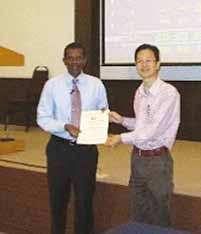
He explained how inclinometer measurements are installed, the data read and the associated errors. It is crucial to study and explain in-depth the associated errors as, on numerous occasions, the anticipated wall lateral movement is not as expected, according to the results of the inclinometer readings.
Errors in installation and measurements as well as method of correcting measurements with systematic errors were presented. Dr Ganesh covered in-depth the types of errors inherent to the inclinometer as follows:
Systematic
Zero Offset / Bias Error Depth Positioning Error
Bias- Shift ErrorCasing Irregularities
Sensitivity Error
Orientation / Spiral Error
Rotational Error
Gravity Error
In the second session, Dr Ganesh presented the standard terms for the design of ground anchors and stressed on the importance of gaining compression in the grouting and introducing the Single Bore Multiple Anchor® system.
He continued his lecture on special features and considerations that need to be taken while designing and installing ground anchors.
The lecture concluded with the 3 criteria for testing of anchors that includes Proving Test, Onsite Suitability Test and On Site Acceptance Test.
The lecture ended at 1.30 p.m. with an question and answer session. There was active discussion from the loor and participants gave Dr V. Ganeshan a round of applause for his well-presented seminar.
On behalf of TUSD, its chairman Ir. Andrew Yeow Pow Kwei presented a memento to Dr Ganeshan.
Title: Evening Talk on “Sustainable Water Supply Technologies for rural Communities”
10th february 2015
Organisedby :WaterResourcesTechnicalDivision
Time :5.30p.m.–7.30p.m.
CPD/PDP :2
Title: Talk on “Introducing the Holistic Management Methodology for railway Systems Projects”
11th february 2015
Organisedby :EngineeringEducationTechnical Division
Time :5.30p.m.–7.30p.m.
CPD/PDP :2
Title: Talk on “INTEgrITY - Our responsibilities and Lessons Learnt” - Postponed from 17 January 2015 (Saturday)
12th february 2015
Organisedby :ProjectManagementTechnical Division
Time :5.30p.m.–7.30p.m.
CPD/PDP :2
Title: Talk on Essential Soft Skills to be A High Performance Engineer
14th february 2015
Organisedby :Oil,GasandMiningEngineering TechnicalDivision
Time :9.00a.m.–11.00a.m.
CPD/PDP :2
Kindly note that the scheduled events below are subject to change. Please visit the IEM website at www.myiem.org.my for more information on the upcoming events.







e deliver a complete, innovaive, and effecive structural precast soluion on our precast building system, integrated with architecture features.
Precast Hollow Core Slab
Precast Prestressed Plank
Precast Double T Slab
Precast RC Half Slab
Precast Column
Precast Beam
Precast Bathroom Unit
Precast Refuse Chute
Precast Staircase
Precast Wall Panel

Senawang Factory: PN45839 Lot 2, Kawasan Perindustrian Pekan Sg. Gadut, 71450 Seremban, Negeri Sembilan,

Website : www.spcind.com

By Ir. Khoo Chee Min
Ir. Khoo Chee Min is currently a Committee Member of IEM Tunnelling and Underground Space Technical Division (TUSTD) and works as Senior Manager in Mass Rapid Transit Corporation Sdn Bhd.
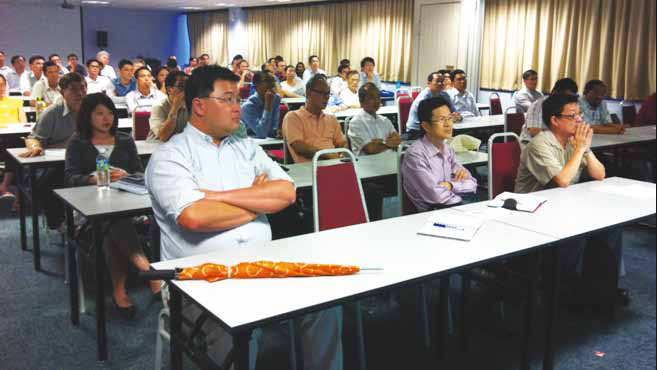
The Tunnelling and Underground Space Technical Division (TUSTD) organised an evening talk on Tunnel Boring & Other Underground Works Of The KVMRT SBK Line on 17th November 2014, at the C&S Room, Wisma IEM.
The speaker was Mr. Gusztav Klados, Project Manager of MMC-Gamuda KVMRT (T) Sdn Bhd for the KVMRT Sungai Buloh – Kajang Line (SBK Line) Underground and Tunnelling Works. A total of 64 participants had attended the talk.
Mr. Gusztav started the talk with a brief overview of SBK Line, the irst line currently implemented under the Klang Valley Mass Rapid Transit project in Malaysia. When completed, the SBK Line will measure a total length of 51km and have 7 underground stations and 24 elevated stations.
The talk focused on the underground section, including the 9.5km tunnelling within the KL city centre.

The tunnels are being constructed by two types of tunnel boring machines (TBM). These are Earth Pressure Balance (EPB) TBM for the
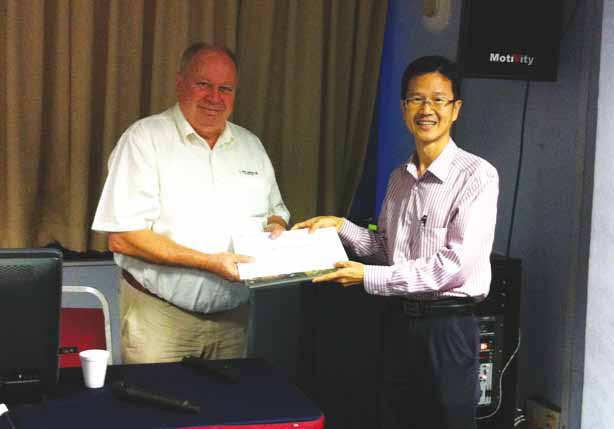
Hill Formation and Variable Density (VD) TBM for the extreme karstic limestone formation. The VD TBM is a slurry machine designed for several modes of tunnelling, both in slurry and EPB, with a facility to vary the density of the slurry. The VD TBM works on a two-pronged approach towards minimising tunnelling risk, primarily caused by ground settlement:
• Higher viscosity slurry prevents loss of slurry into the cavities and this in turn prevents sinkholes
• Higher viscosity slurry prevents slurry from looding the ground surface, hence helping to maintain the pressure between the cutterhead and the excavated surface, therefore minimising incidence of sinkholes.
This technological innovation is the irst of its kind in the world and the contractor is proud to announce that the tunnelling in KL karst limestone has been completed successfully by VD TBM with just 2 minor sinkholes reported.
This is a major improvement compared to SMART project (i.e. 41 major ground collapses). This translates to 4.6/km sinkholes for SMART vs 0.3/km sinkholes for KVMRT. Other new techniques in tunnelling for this project include the full adoption of steel ibre reinforced concrete (SFRC) tunnel segment lining with universal rings (7 + 1 key), except hybrid lining to be used for certain areas (e.g. Pudu).
Mr. Gusztav then highlighted the key design features and engineering challenges faced at each underground station, of which some had been identiied during tender and design stages while new challenges were encountered during construction. All 7 underground stations were being constructed using cut-and-over method with maximum excavation depths of up to 40m below ground level for the Tun Razak Exchange (TRX) Station.
For those in the Kenny Hill formation, construction followed the top-down process while those in KL limestone were designed for bottom-up sequence. Mr. Gusztav also shared his opinion that top-down construction was preferred and could be more economical than conventional braced excavation with extensive temporary strutting.
Apart from the above, the talk also provided participants with the latest updates on the KVMRT project with regards the progress of the various components of the underground section.
At the end of the talk, there were discussions and questions raised by the participants. Then the Chairman of TUSTD presented a memento to Mr. Gusztav, followed by a round of applause from the participants.


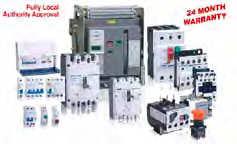














By Ir. P.E. Chong
Ir.
P.E. Chong, IEM Vice President, concurrently the Secretary General of AFEO.

The ASEAN Federation of Engineering Organisations (AFEO) is made up of the 10 national engineering organisations in ASEAN countries. Its main activity, Conference of AFEO (CAFEO), is held annually in one of the 10 countries, on a rotation basis according to alphabetical order.
This year’s CAFEO 32 (the number indicates how many times CAFEO has been held so far), was organised by Myanmar Engineering Society (MES) and held in Yangon, Myanmar, from10th to12th November,2014.Myanmarheld the chair of AFEO for 2014 until the conclusion of CAFEO 32.
The event proceeded as planned in Hotel Sedona. The Governing Board meeting was held back-to-back with this annual event for a get-together at the end of the year. More than 600 participants from various parts of Asia and South East Asia attended.
EVENT PrECEDED CAfEO 32: TrIPS BY CHAIrMAN
Of AfEO
The Chairman of AFEO and President of Myanmar Engineering Society (MES), Ir. U Win Khaing made one trip to the AFEO Secretariat for meetings and discussions, among others,
on the arrangement for technical and other meetings.
The Secretariat also met Ir. U Win Khaing earlier in the hotel lobby for discussions on his personal trip to Kuala Lumpur.
WELCOMINg rECEPTION
The Welcoming Reception, held a day before the Opening Ceremony, allowed all participants to meet, network and get know each other. It was very well attended with plenty of food and drinks to go along with it.
OPENINg CErEMONY
The Conference was preceded by a golf competition among the heads of delegations

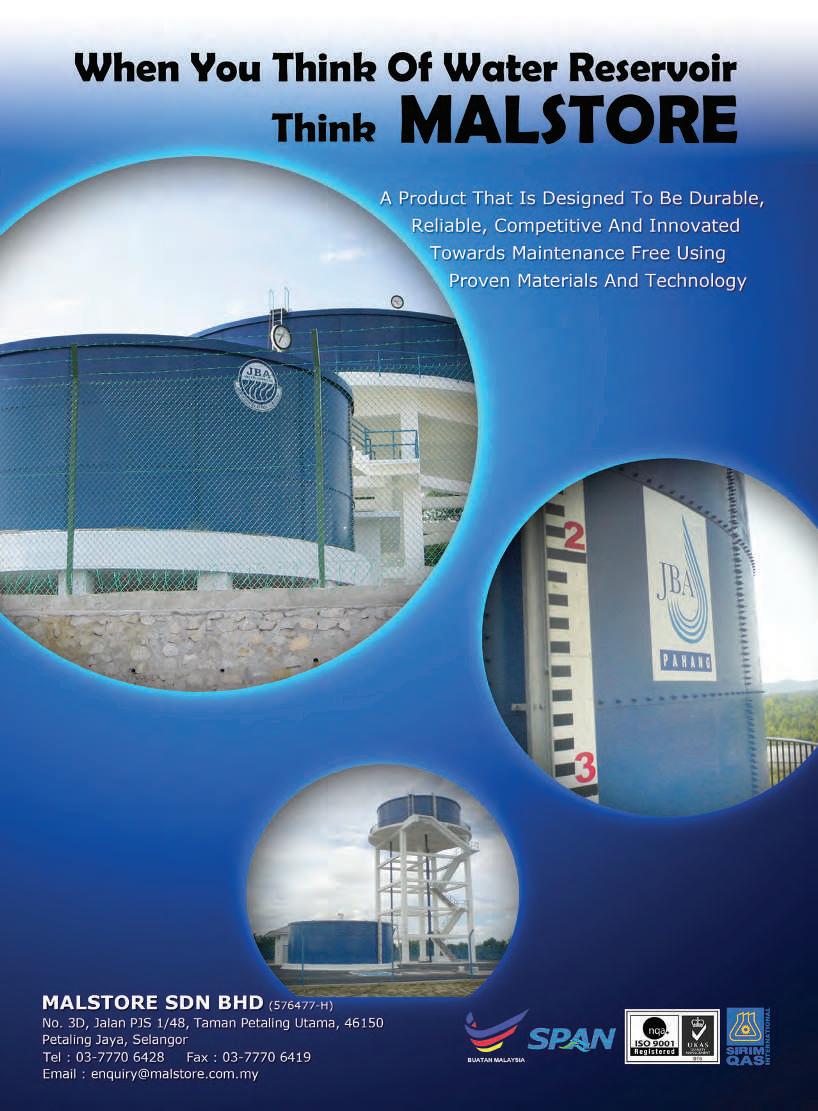
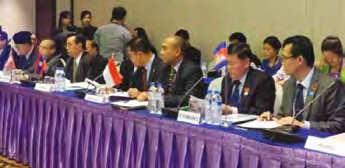
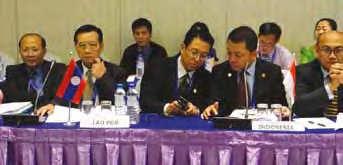

and some delegates in the early morning. This was followed by the presentation of some technical papers. There were other activities in the afternoon as well on the day before the Conference proper.
On the second day, the grand Opening Ceremony started at 9.00 a.m., oficiated by H.E U Kyaw Lwin, Union Minister of Construction, Myanmar, and H.E U Myint Swe, Chief Minister of Yangon Region, Myanmar.
The ceremony started early to accommodate a special visit to Naypyitaw, the administrative capital of Myanmar. After the ceremony, all the Heads of Member Organisations and other AFEO Ofice Bearers left immediately for the airport to board a plane for Naypyitaw to attend and witness the conferment ceremony of Distinguished Honorary Patron award to His Excellency, U Thein Sein, President of the Republic of the Union of Myanmar. The ceremony took place at the President’s Palace.
The delegation was given VVIP treatment by the Myanmar government which provided a return chartered light from Yangon. Unfortunately the original outbound plane intended for the light developed a technical glitch, so we were transferred to a commercial light which was diverted to Naypyitaw to ensure that the delegation would arrive at thePalaceintimeforlunchasthePresidentwasavailablefor the conferment and lunch with the delegation. The President was extremely busy as he had to meet and entertain the overseas heads of States, including US President Barrack Obama who was there for the ASEAN Summit.
We understood that the other passengers on this commercial light were not aware that the plane was being diverted and they were not allowed to disembark when the plane landed in Naypyitaw.
WeweretakenimmediatelytotheVIPloungefortransfer to vehicles that would take us to the Palace, accompanied by police outriders. The roads leading to the Palace were lined with policemen to ensure that the journey to the Palace was not interrupted by trafic at the many road junctions.
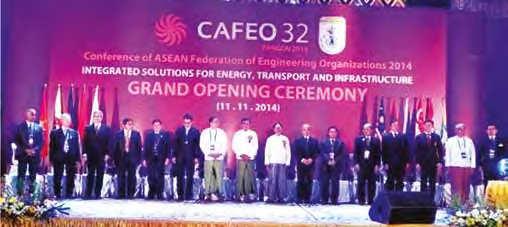
All the way, we were accompanied by the Minister of Construction, HE U Kyaw Lwin, his Deputy, HE Dr Win Myint, and other high ranking oficers.
After the conferment ceremony, the delegation was entertained to lunch by HE U Thein Sein, President of the Republic of the Union of Myanmar.
Back in Yangon, the Workshop on Transportation and Logistics aswellasconferencetechnical sessions continued. There were

many different engineering displays at the exhibition booths located at the entrance to the Conference Ballroom. Besides the conference sessions, the working group meetings, Young Engineers of AFEO (YEAFEO) and Woman Engineers of AFEO (WE-AFEO) meetings also went on as scheduled.
WE-AFEO was formed only in 2013 to discuss women engineer issues within the ASEAN countries. The Energy and Environment Work Group was chaired by Malaysia, Education and Capacity Building by Singapore, and the Transportation and Logistic and the Disaster Support was chaired by Thailand.
Country Reports were presented by the respective Heads of member organisations that afternoon upon their return from Naypyitaw. The day ended with the ASEAN Engineers Register Commission meeting in the evening.
The AFEO Board meeting also discussed the possibility of member organisations coming together with a Declaration to be announced as the Yangon Declaration II. This was a follow-up to the Yangon Declaration signed 10 years ago in Yangon.
The Yangon Declaration II signing ceremony was held at 4.30 p.m. in the presence of the members of the Press and TV
from Myanmar. This Declaration can be viewed at the AFEO website: afeo.org.
In the evening, there were lively activities including the presentation of awards for best engineering projects, feats and individuals of the various ASEAN countries. Outstanding engineers and eminent personalities were also conferred Honorary titles. These were followed by lively performances of singing and dancing, by delegates and young engineers from the various countries.
The handover ceremony was also held during the grand Gala Dinner. By rotation, after Myanmar, it now falls on IEM (Malaysia) to hold the AFEO Chair and to host CAFEO 33 in 2015. The AFEO flag was handed over to IEM President Dato’ Lim Chow Hock, marking the end of CAFEO 32.
IEM Penang Branch has been tasked to organise this event for CAFEO 33 which will be held in Penang, Malaysia. The Organising Chairman of CAFEO 33 is Immediate Past Branch Chairman Ir. Paul Por Chi Wei. Assisting him will be the current Penang Branch Chairman Ir. Dr Mui Kai Yin and his committee while IEM Standing Committee of Activities will be tasked to help in the co-ordination.
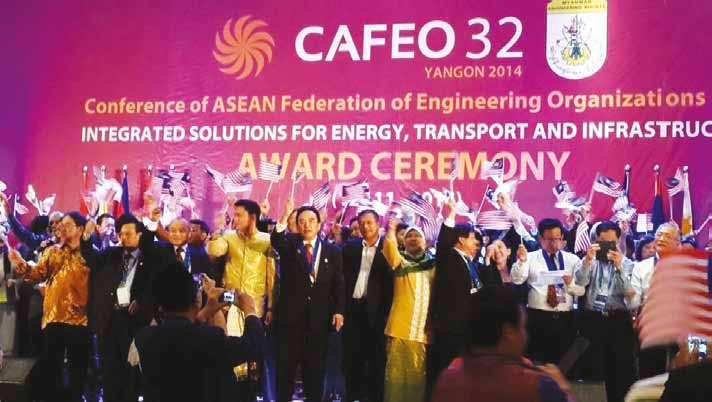
Invitations were extended to all participants from ASEAN and ASIA to CAFEO 33 which was expected to be held from 22nd to 26th November, 2015.
The night ended with lots of singing and dancing, marking the end of a very successful conference.
• Provide management on all phases of construction project including coordinating workers, material and equipment.
• Ensuring projects specification are being comply with, completed based on schedule and within budget.
• To conduct feasibility study and prepare report on new properties to be acquired by the Company.
• To liase with Consultants and Authorities for all development approvals/endorsements/ clearance.
• To shortlist, participate in negotiation for best terms and price and submit recommendation for award of contracts.
• To verify all progress payment certificates are in correct quantity and quality.
• Ability to work under constant time pressure
• Ability to promote teamwork and effectively monitor the progress of all projects entrusted to the incumbent.
• Good negotiation and conflict resolution skills.
• Degree in Civil Engineering, Building, QS or equivalent professional qualification.
• At least 3 years’ experience and above in related field.
• Conversant with all laws, regulations and procedures related to property development.
• Analytical with good negotiation skills.
• Possess expertise in documenting SOP and knowledge on ISO requirements.
• Willing to travel extensively to visit site projects.
• Full time position available.
ONLY SHORTLISTED CANDIDATE SHALL BE NOTIFIED
Email: laukeath@pristana.com
• Ensure that all consultants and contractors perform to the company’s requirement.
• To develop, implement cost effective and economic project management approaches. This involves scrutinizing consultant’s designs to ensure that the designs are economical and maximise returns to the company.
• Establish and maintain close working relationship with the relevant Government agencies to facilitate the operations of the company.
• Continually lead, train and motivate subordinates. Instils discipline and develop attitudes that encourage productivity, dedication and innovation.
• Good interpersonal skills.
• Ability to handle multiple projects simultaneously.
Thehosthadkindlyorganisedtechnicalvisitstovariousplaces of interests on Day 3, 13th November. These included Nyaung Done Bridge, Mini Hydro Power Improvement Project, Bago Division and Thaukyegat 120 MW Hydro Power Station.
Some sites took 3-8 hours of travelling time by coach and a total of 7 buses left for the various destinations.
Those who did not take part in these visits returned home while some stayed on for social tours and shopping in Yangon. Most delegates returned home on 14th November.
MYANMAr ENgINEErINg SOCIETY, HOST Of CAfEO 32 AND ALL:
We are dynamic, growth orientated and progressive public listed Company involved in property development within Klang Valley, Sabah and Sarawak. Our group of companies are also into diversified business in manufacturing of industrial gas, ready mixed concrete, pre-cast product, timber door manufacturing and trading. In line with our growth and expansion, we seek suitably qualified candidate with a desire to build a successful career in our Company.
Min 3 years experience Malaysia - Selangor - Shah Alam
On behalf of AFEO, we wish to thank the government of the Republic of the Union of Myanmar for its support, through its relevant Ministries and Departments and agencies, in renderingalltheassistancerequiredforthesuccessofCAFEO 32 in Yangon. This was also made possible by the good leadership, great effort and excellent work by the Myanmar Engineering Society led by Ir. U Win Khaing, its hardworking organising committee and other volunteer members.
We also wish to thank AFEO Heads of Delegations and delegates coming from far and near for their enthusiastic participation and the generous sponsors without whom CAFEO 32 would not have achieved such great success. Thank you very much. A Very Happy New Year 2015 to all.

Kuala Lumpur 12-13 January (closed) 16-17 March 18-19 May
Miri 9-10 February 20-21 April 22-23 June
Singapore 26-27 January (closed) 30-31 March 1-2 June
This course will provide participants with a broad understanding of the LNG industry, the LNG value chain, and an approach to FLNG (Floating Liqueied Natural Gas) ield development planning. This includes a review of the fundamentals of naval architecture, hull design, and LNG containment systems for FLNG facilities. The course will also cover the marine engineering discipline, gas receiving, pre-treatment and liquefaction processes, oloading of LNG and regasiication processes, operational challenges and technical risks, and inancial and contracting strategies for FLNG and FSRU (Floating Storage & Regasiication Unit) projects. Aspects of the Shell Prelude FLNG and PETRONAS PFLNG will be shared. The objective is to provide participants with a strategic overview covering both technical and commercial knowledge, which will enable participants to make informed decisions and help them in planning their respective FLNG and FSRU projects.
Kuala Lumpur Tunku Elisha +6012 416 2546 elisha@dreamcatcher.asia
Miri Hsien Loong +6016 338 2426 hltie@dreamcatcher.asia
Singapore Cheng Yian +65-9671 1174 cytan@dreamcatcher.asia
* training dates subject to change
contract, commercial and procurement | discipline engineering | ield development | health, safety, environment and quality | ofshore engineering ofshore marine & shipbuilding | onshore plants | project management
TUNNELLING AND UNDERGROUND SPACE TECHNICAL DIVISION

By Ir. Dr Ooi Teik Aun
Ir. Dr Ooi Teik Aun is the Founder Chairman of the IEM Tunnelling and Underground Space Technical Division and an Organizing Chairman of the International Conference & Exhibition 2015 (ICETUS2015. He is also the current Chairman of Dispute Resolution Practice (DRP) Subcommittee. He is an Advisor for Consulting Engineering Special Interest Group (CESIG). Ir. Dr Ooi is an Honorary Fellow of IEM, Fellow of the Malaysian Institute of Arbitrators and Past President and is ICE Country Representative for Malaysia. He is President of Southeast Asia Geotechnical Society (2010-2016).
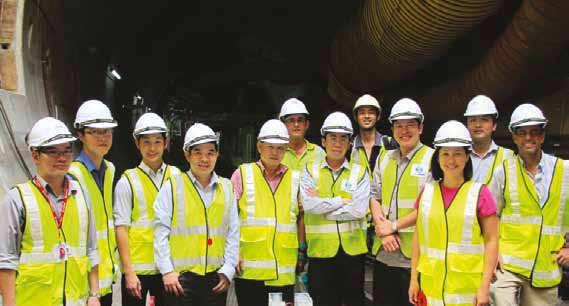
On 26th July 2014, the Tunnelling And Underground Space Technical Division (TUSTD) of IEM organised a half-day seminar on “Overview of Design & Construction of Deep Excavation and Tunneling Projects in Singapore” at Wisma IEM. It attracted about 80 participants, including students from the ICE Student Chapter of University of Nottingham Malaysia Campus. This seminar was made possible as the two speakers - Er. Dr Victor Ong Chee Wee and Er. David Ng Chew Chiat - made a


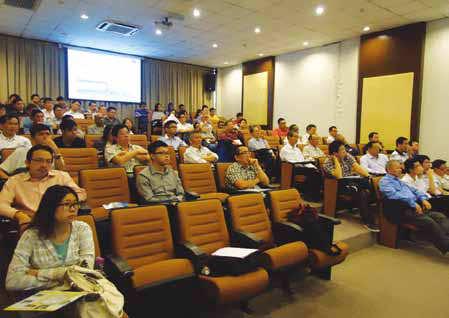
special trip to visit KVMRT in Kuala Lumpur a day earlier so that they could share their expertise and experience on the subject matter with members of IEM.
The speakers are consultants based in Singapore and are involved in the MRT projects in both Malaysia and Singapore.
They elaborated on the design and construction of deep excavation and bored tunnelling projects in Singapore. They stressed that the design and construction of bored tunnelling and temporary works for deep excavation rely on moderately conservative ground parameters, robust design solutions and close engineer’s supervision to limit movements of both the temporary works system and surrounding ground or structures to within acceptable limits, which is particularly true when working in an urban environment.
Instrumentation results also need to be precise and accurate to enable the construction works to proceed in a controlled manner and the instrumentation layout needs to be designed with careful consideration of the excavation and each instrument located with a speciic purpose.
The talk ended with an active Q&A session as well as interactive discussion on the various issues of design and construction of deep excavation and bored tunnelling. Certiicates of appreciation as well as IEM heritage books were presented to Er. Dr Victor Ong and Er. David Ng at the end of the session.
BOMBA CIrCULArS
Members at times ind dificulties in getting the latest Bomba circulars which will have a major impact on the design of the ire ighting systems. In this respect, FAB has undertaken to provide all future circulars from Bomba and these circulars will be uploaded to the IEM website. Members are now able to check the latest Bomba circular under the heading of Publication. FAB is unable to compile all the previous circulars and will only upload the circulars which is available.
Thank you.
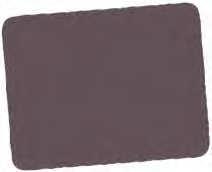




By Ir. Raftah Mahfar
Ir. Raftah Mahfar is currently a Director of SCG Consultants Sdn. Bhd., a Structural, Civil, Infrastructure, Geotechnical and Railway engineering Consultants.
Ir. Raftah is active as Corporate Member of Institution of Engineers, Malaysia (IEM) and a Professional Interviewer for IEM’s Professional Interview. She is the committee member of IEM Women Engineers from year 2008 and the Chairperson of IEM Women Engineers SubCommittee for session 2012/2013. Presently, she was Chairman of IEM-WE Section for Session 2013/2014.
Aone-daycourseonIntroductionToLiDAR Survey Technology was organised by the IEM Woman Engineer section (IEMWE) on 6th August, 2014, at Wisma IEM, Petaling Jaya. A total of 14 participants attended the course.
The course was conducted by Engr. Trudy R. Ganendra, who had successfully completed over 60 LiDAR projects in different applications at national and international levels. She is the Managing Director of Ground Data Solution R&D Sdn. Bhd. (GDS), a Malaysian high-tech mapping and surveying service provider, specialising in airborne LiDAR survey.
First, she introduced LiDAR survey technology. LiDAR is formally known as Light Detection And Ranging, a laser mapping technique in which laser pulses are emitted towards the surface and the time for their return is measured. There are five types of LiDAR data: Airborne LiDAR, Bathymetric LiDAR, Terrestrial Mobile & Fixed LiDAR, Handheld LiDAR and Waveform LiDAR.
LiDAR data consist of three main components – Global Positioning System (GPS), Inertial Measurement Unit (IMU), and Laser Scanner. Processing the data from these 3 sensors together generates 3D “point cloud” of the mapped area. Each of the component details is listed in the Table 1 below:
GPSUsed to precisely locate the position of the scanner during the measurement
IMUMeasure the angular changes thereby allowing the analyst to determine the orientation of the scanner
Laser ScannerUsing accurate timing, the distance to the featured can be measured
During laser scanning, laser pulses are directed towards the ground, usually by a movable reflecting surface (mirror) which
orients the individual pulses into a scanning swath.
There are two primary styles of scanning, namely Rectilinear (even spacing) and Galvanometric (sinusoidal) as well as another less prevalent style, Orbital (circular).
The details of both primary styles are listed below:
Use multiple mirror faces Use single mirror
Rectilinear point spacing with easy mechanics
Improved surface triangulation geometry
Adjustable swath width
High pulse utilisation
Eg. Riegl scannerEg. Optech scanner
Easier analysis due to even spacing
Less easy analysis
The LiDAR survey procedure started with system calibration and ended with final deliverables (Figure 1 below):
Ms. Trudy further explain that LiDAR survey is cost effective for medium to large mapping area/corridor, fast data collection, has negligible impact on the environment, cloud free imagery, robust against weather conditions, accurate measurement in dense forest and steep terrain, independent of sun angle and acquisition based on accurate GPS network. For Airborne LiDAR survey, data acquisition using manned aircraft, will produce good, quality LiDAR data and imagery compared to using Unmanned Aerial Vehicle (UAV).
More cost effective for large areas (>10km)
Able to fly in much more challenging terrain and weather condition
Cost effective for small area (>1 km)
Not applicable for urban area with high rise building or challenging terrain and weather conditions
Long flight timeShort flight time compared to the manned aircraft
Able to fly in most airspaces Highly dependent on civil aviation authority approval
Ability to fly very low altitudes
LiDAR survey is suitable for engineering purposes as it offers detailed and accurate topography survey even in challenging terrain. Some applications of LiDAR data arelisted in the Table 4 below:
Infrastructure/ Engineering:
Environment / Disaster
Natural Resources
• Road/Railway/ Pipeline
• Transmission line
• Dam survey
• Flood Mapping
• Slope Mapping
• Telecommunication & Urban Planning
• Forest / Agriculture
• Water catchment
• Mine Site
In the 2nd session of the workshop, Ms. Trudy gave an introductiontotheLiDARprocessingsoftwarenormallyusedby the LiDAR provider. These are Microstation with TerraScan and TerraModeler tools and MARS Viewer - a LiDAR freeware. The software is used to read, view and edit LiDAR points, to classify LiDAR points, surfacing, contouring and can easily handle tens of millions of points with optimum performance.
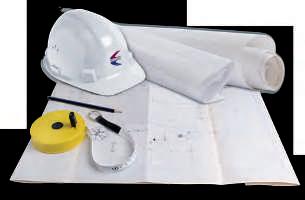




Microstation is a CAD software product for 2D and 3D dimensional design and drafting works. Microstation offers a robust sub system for consistent integration of geometry and LiDAR data.
TerraScan and TerraModelerare dedicated software solutions for processing laser-scanning points and creating
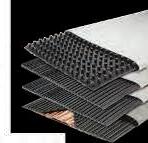
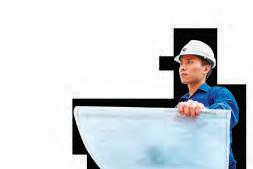
Creating connections. Maintaining connections.
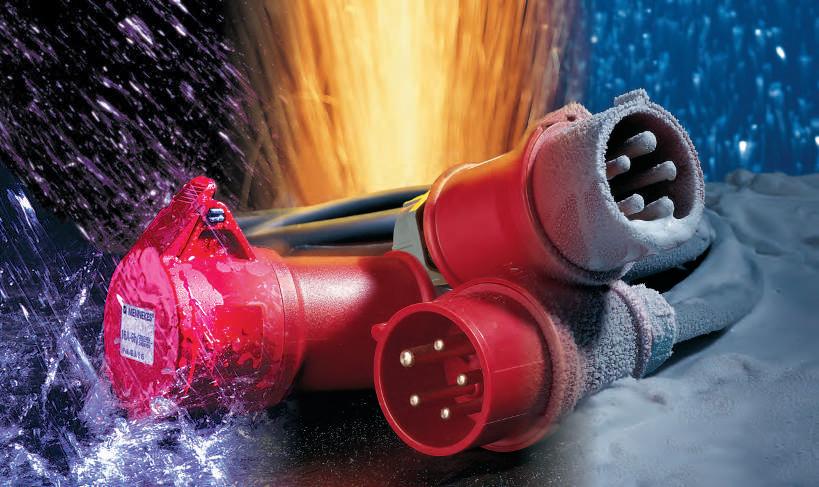
Industrial plugs and sockets.
Elektrotechnik GmbH & Co. KG (Malaysia Representative Ofice) 10, Jln Lep 7/26, Sek 7
Tmn Lestari Putra, Bdr Putra Permai 47110 Seri Kembangan, S‘gor, M‘sia Phone +60 (3) 8957 4487 Mobile +60 12380 6996 amandaliew@mennekes.my www.MENNEKES.de


fully-featured terrain models. The MARS viewer is user-friendly freeware software which has a viewing application, support basic LiDAR data navigation and 3D visualisation for casual users. With MARS viewer software, we can read LiDAR point cloud, orthophoto image, view point cloud in different modes, 3D and profiling.
Ms. Trudy also shared her experience in utilising LiDAR data by using Power Line System – Computer Aided Design and Drafting (PLS-CADD) software for new transmission route alignment design and Modelling of Surface with String (MOSS)/MX software for civil engineering works.
During the hands-on session, GDS staff assisted participants in exploring LiDAR point cloud data using Microstation andfreeware software. They were guided in these procedures:
• Reading the point cloud and orthophoto image
• Viewing LiDAR data in different modes, 3D visualisation and view point cloud profile
• Measuring point density for all points including ground points, checking vertical accuracy, check point spacing and pixel resolution calculation.
The course ended with a note of appreciation from the organiser to Miss Trudy, followed by taking of photographs of all participants and organiser.

RECOGNISED LEADER IN PRESTRESSED CONCRETE PILES
Cost Effective and Safe Solution forYourFoundation


Stresscon piles are high strength prestressed concrete square section piles specially designed for low to medium rise buildings and light civil engineering structures namely factories, low-rise apartments, terrace houses and shop houses.
Plenty of Stocks
High production rate
Experienced with more than 1000 projects in all kinds of soil conditions, including ex mining ground, marine soil, limestone formation and very hard ground.
Technical transferfrom renowned prestressed concrete pile manufacturer– Hi-Stress Concrete Ltd., New Zealand.

New Zealand Engineers are in discussion with ourMalaysian Engineers
STRESSCON PILING (M) SDN BHD (114405-H)
25-2, Block C, Jalan 2/109F, Taman Danau Desa, 58100 Kuala Lumpur, Malaysia.
Tel: 603-7981 0061 Fax: 603-7981 8433
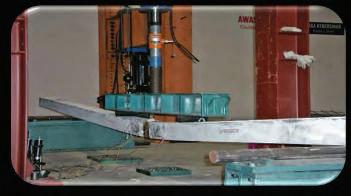
Bending Test by Department of Civil Engineering in the University of Technology Mara (UiTM) Shah Alam

Factory Address: Lot 261, Jalan Sungai Lalang, Mukim Ulu Semenyih, 43500 Semenyih, Selangor Darul Ehsan. Contact: stresscongroup@yahoo.com www.stresscon.com.my



Ir. Chin Mee Poon
www.facebook.com/ chinmeepoon
Ir. Chin Mee Poon is a retired civilengineerwho derives a great dealof joy and satisfaction from travelling to different parts of the globe, capturing fascinating insights of the places and people he encounters and sharing his experiences with others through his photographs and writing.
On the 10th day of our trip in Alaska, our ferry M/V Malaspina docked at the ferry terminal in Skagway, a small town nestled at the northern end of the Inside Passage in southeast Alaska.
We started our voyage up the Inside Passage from Bellingham in Washington State of USA andmade overnight stops in Ketchikan, Wrangell, Petersburg and Juneau.
Like our earlier stops, Skagway was also a lovely place to spend a day or two in, but to get to the rest of Alaska from here, we would have to travel overland as the ferry service linking southeast Alaska with south-central Alaska was not available in September. In fact, even public buses stopped running at this time due to lack of demand, so we would have to drive.
Fortunately there was a car-rental company in Skagway and the drive from
Skagway to Fairbanks in central Alaska via Whitehorse in the Yukon Territory of Canada turned out to be a very pleasant one for several reasons – the roads were generally in very good condition, trafic was very light, many sections of the road passed through spectacular scenery and we did not encounter any inclement weather.
My wife and I took turns to drive. When my wife was at the wheel, I was able to capture the beautiful scenery with my camera without havingtostopthecar.ThedrivefromSkagway to Whitehorse was particularly enjoyable as the full splendor of autumn colourscould be seen along most of the way. We frequently stopped our car to take in the view.
As if that was not enough to quench our appetite for nature’s beauty, we had the extremely good fortune to run into a mother grizzly bear and her two cubs. That rare encounter was really the icing on the cake for us.
The encounter took place when we were on our way to Whitehorse. We were attracted by the sight of a few cars which had pulled over to the side of the otherwise quite deserted road. Experience told us that the motorists must have been attracted by something interesting at the side of the road.
Sure enough, as we joined the motorists, we saw a mother grizzly bear and her two cubs busy eating berries. We thanked our lucky stars for having come to the right place at the right time as just a few minutes later, the bears had eaten their ill of berries and promptly disappeared into the forest. Motorists who arrived at the scene a few minutes after us, were disappointed.
In Alaska, there are three species of bears: Brown, black and polar. Grizzly bears are a subspecies of the brown bear. They are found inland and subsist largely on grass, whereas brown bears are found along the coast and are larger in size than grizzlies because of the abundance of salmon in their territory.
ToAllMembers,
Tarikh:12January2015
Berikut adalah senarai calon yang layak untuk menduduki TemudugaProfesionalbagitahun2015.
Mengikut Undang-Undang Kecil IEM, Seksyen 3.9, nama-nama seperitersenaraiberikutditerbitkansebagaicalon-calonyang layakuntukmenjadiAhliInsitusi,dengansyaratbahawamereka lulusTemudugaProfesionaltahun2015.
Sekiranya terdapat Ahli Korporat yang mempunyai bantahan terhadapmana-manacalonyangdidapaiidaksesuaiuntuk menduduki Temuduga Profesional, surat bantahan boleh dikemukakankepadaSeiausahaKehormat,IEM.Suratbantahan hendaklah dikemukakan sebulan dari tarikh penerbitan dikeluarkan.
ir. gunasagaran Kristnan Seiausaha Kehormat, IEM, PERMOHONAN BARU NamaKelayakan
KEJURUTERAAN AWAM
KHIRWANI BINTI MAHAMAD KATORBE HONS (UiTM) (CIVIL, 2005)
MOHD AZIM BIN MOHD AZMI BE HONS (UiTM) (CIVIL, 2007)
NORUATI BINTI NORDINBE HONS (UKM) (CIVIL & ENVIRONMENTAL, 2000)
RIZAL BIN ARIP BE HONS (UTM) (CIVIL, 1997)
SITI SUNAIZAH BT JAAFARBE HONS (UTM) (CIVIL, 2002)
THOMSON LAI TECK YONG BE HONS (UTM) (CIVIL, 2007)
KEJURUTERAAN KIMIA
NORLINDA BINTI NASIDINBE HONS (UTM) (CHEMICAL, 1999)
KEJURUTERAAN ELEKTRIKAL
CHANG TZE WU BE HONS (BRIGHTON) (ELECTRICAL & ELECTRONIC, 1996)
GABRIEL ANAK JATU BE HONS (UTeM) (INDUSTRIAL POWER, 2006)
HUNG SING YIE BE HONS (UMS) (ELECTRICAL & ELECTRONIC, 2002)
MAH SONG LINGBE HONS (MULTIMEDIA) (ELECTRICAL, 2002)
KEJURUTERAAN ELEKTRONIK
MOHD SARIZAL BIN AHMAD BAKERYBE HONS (UTP) (ELECTRICAL & ELECTRONICS, 2002)
ROSDIAZLI IBRAHIMBE HONS (UPM) (ELECTRONIC/COMPUTER, 1996)
KEJURUTERAAN MEKANIKAL
CORNELIUS CHIN MIN FONGBE HONS (UPM) (MECHANICAL, 2007)
SHAMSHIMAH BINTI SHAMSUDDINBE HONS (MALAYA) (MECHANICAL, 2002)
KEJURUTERAAN HIDRAULIK
JASICA CHUABE HONS (UKM) (CIVIL & ENVIRONMENTAL, 2001)
KEJURUTERAAN PEMBUATAN
ABANG HELMI ABANG ABDUL MANAP BE HONS (UKM) (MANUFACTURING, 2007)
KEJURUTERAAN SUMBER MINERAL
AHMAD ZUKNI BIN AHMAD KHALILBE HONS (USM) (MINERAL RESOURCES, 1998)
KEJURUTERAAN TELEKOMUNIKASI
ASWAN NORHAIRIS BIN CHE OMARBE HONS (UiTM) (ELECTRICAL, 2001)
NELSON BENEDICT MODILIBE HONS (RMIT) (ELECTRICAL, 2000)
KEJURUTERAAN TRAFIK
RAVI SHANKAR A/L R. AYAPPAN BE HONS (UM) (CIVIL, 1993) MSc (UTM) (TRANSPORTATION PLANNING, 1999)
PERPINDAHAN AHLI
No. Ahli NamaKelayakan
KEJURUTERAAN AWAM
70417AZURA BINTI MEGAT IBRAHIMBE HONS (UKM) (CIVIL & STRUCTURAL, 2000)
21715 CHAI TZER LUEN BE HONS (UTM) (CIVIL, 2005)
33805CHAN WEI THIENBE HONS (WESTERN AUSTRALIA) (CIVIL, 2006)
37903CHEONG FONG CHINBE HONS (SOUTHERN QUEENSLAND) (CIVIL, 2005)
71144HAZLAN BIN MOHDBE HONS (MALAYA) (CIVIL, 2003)
37216HISHAM BIN MOHAMADBE HONS (UTM) (CIVIL, 2002)
29601LEE CHONG LEANBE HONS (UTM) (CIVIL, 2006)
62181LIEW SU FUAN BE HONS (UNITEN) (CIVIL, 2004) MSc (PORTSMOUTH) (CIVIL, 2005)
49896MOSES SONDOHBE HONS (UNIMAS) (CIVIL, 2005)
29873PANG KET SOONBE HONS (USM) (CIVIL, 2008)
22952 SITI AISHAH BINTI ABDULLAH BE HONS (UTM) (CIVIL, 2000) MSc (UiTM) (CIVIL-STRUCTURES, 2009)
43519TAN CHEE HOONGBE HONS (UM) (CIVIL, 2008)
50122TIEN LOY BONGBE HONS (CANTERBURY) (CIVIL, 2010)
70430WAN LOKMAN BIN WAN YUSOFFBSc (NEVADA) (CIVIL, 1989) MSc (HERIOT WATT) (CONSTRUCTION PROJECT MANEGMENT, 2013)
61170WAN MUHAMAD FAHMI BIN WAN ZAKI BE HONS (UiTM) (CIVIL, 2007)
KEJURUTERAAN ELEKTRIKAL
30644ADLIE BIN MOHD ALIBE HONS (UPM) (ELECTRICAL & ELECTRONICS, 2003)
41113 MOHD FIRDAUS BIN JALALUDDINBE HONS (UNITEN) (ELECTRICAL POWER, 2009)
53790MOHD NAZMI BIN ABDUL RAMANBE HONS (UNITEN) (ELECTRICAL POWER, 2010)
36331MUHAMAD FARIZ B. MD BAKIRBE HONS (UTM) (ELECTRICALMECHATRONICS, 2006)
49414MUHAMMAD FITRI BIN AYOB BE HONS (UTM) (ELECTRICAL, 2010) ME (UNITEN) (ELECTRICAL, 2014)
43137PUAH KUAN HUABE HONS (MULTIMEDIA) (ELECTRICAL, 2009)
37278TAN JACK CHEONG, VINCENT BE HONS (LIVERPOOL) (ELECTRICAL,1997)
54003TAN WEI HOWBE HONS (USM) (ELECTRICAL, 2004)
50192WAN FAMY AZLI BIN WAN AHMADBE HONS (UiTM) (ELECTRICAL, 2008)
73461ZAKARIA BIN HUSSAINBE HONS (HUDDERSFIELD) (ELECTRONIC & ELECTRICAL, 1997) PhD (SHEFFIELD) (2010)
KEJURUTERAAN ELEKTRONIK
49609MOHAMMAD 'AFIF BIN KASNOBE HONS (UTM) (ELECTRICAL - ELECTRONICS, 2008)
51347MOHD OSNIZAM BIN OTHMANBE HONS (UKM) (ELECTRICAL, ELECTRONIC & SYSTEMS, 2001)
54285SITI FAUZIAH BINTI TOHABE HONS (UTP) (ELECTRICAL & ELECTRONICS, 2003) MSc (USM) (ELECTRONIC SYSTEMS DESIGN, 2006) PhD (SHEFFIELD) (2010)
KEJURUTERAAN PERTANIAN
20136JIVARATNAM S/O RAMASUNDARAM BE HONS (UPM) (AGRICULTURAL, 1997)
KEJURUTERAAN MEKANIKAL
42321ANG KIAN HOBE HONS (UMS) (MECHANICAL, 2010)
41976MOHAMMAD MAZMASHAHRIL BIN MAZLAN BE (MINNESOTA) (MECHANICAL, 2005)
32610MOHD FAHMI BIN MOHAMAD JAAFAR BE HONS (UNITEN) (MECHANICAL, 2007)
13606MOHD SHAMSUNAHAR BIN MOHD. SAID BE HONS (LONDON) (MECHANICAL, 1990)
27528 MOHD SHUKRY BIN ABDUL MAJID BE HONS (UMIST) (MECHANICAL, 2001)
52330NORAZHA BIN ZAIDIBE HONS (UKM) (MECHANICAL, 2006)
CONTRIBUTIONS TO WISMA IEM BUILDING FUND
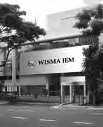
RM 2,515,014.20 from IEM Members and Committees RM 741,502.00 from Private Organisations
(ANOTHER RM 4,316,997.60 IS NEEDED)
TOTAL RM 4,316,997.60
The Insituion would like to thank all contributors for donaing generously towards the IEM Building Fund HELP US TO PROVIDE BETTER SERVICES TO YOU AND TO THE FUTURE GENERATION (The donaion list to the Wisma IEM Building Fund is published on page 21)
Note: This is a coninuaion of the list which was irst published on page 47 of the January 2015 issue.
68502CHIN MING JUN 1ST YEAR(MONAS) (ELECTRONIC)
67039 FARIS AMSYAR B. AHMAD ZHAKI 1ST YEAR(USM) (ELECTRONIC)
68270 FAUZI B. ABDULLAH 1ST YEAR(UTHM) (ELECTRONIC)
68271 FOO SIAW YIAN1ST YEAR(UTHM) (ELECTRONIC)
68272 FUAD AKMAL B. MOHAMAD ZAHIR 1ST YEAR(UTHM) (ELECTRONIC)
68273GO HONG KENG 1ST YEAR(UTHM) (ELECTRONIC)
67040 GOH DUAN YEONG1ST YEAR(USM) (ELECTRONIC)
68503 GOH PEI YUEN1ST YEAR(MONAS) (ELECTRONIC)
68047HAFSAH BT. HASIM 4TH YEAR(UTHM) (ELECTRONIC))
68274HAKIMIE B. BAKRI 1ST YEAR(UTHM) (ELECTRONIC)
68275HAPISAH BT. HANAPI 1ST YEAR(UTHM) (ELECTRONIC)
67041HO KUEN SENG 1ST YEAR(USM) (ELECTRONIC)
68827INTAN NURELYANA BT. SAHAT 1ST YEAR(UTHM) (ELECTRONIC)
68276 JANE ANN CHERYL YATAN 1ST YEAR(UTHM) (ELECTRONIC)
67042JUMSIYE BT. SALLEH 1ST YEAR(USM) (ELECTRONIC)
68277KHAIRIL NIZAM B. MOHD FOUZI 1ST YEAR(UTHM) (ELECTRONIC)
68278KHAIRUL FAKHRI B. ABDUL GHANI 1ST YEAR(UTHM) (ELECTRONIC)
68828KHAIRUL HAFIZI B. DAMIRI 1ST YEAR(UTHM) (ELECTRONIC)
68829KHAIRUL MUJIBAH BT. MOHAMED @ MAHMUD 1ST YEAR(UTHM) (ELECTRONIC)
68279KHAIRUL NIZAM B. ANUAR 1ST YEAR(UTHM) (ELECTRONIC)
68280 KWONG JUN YE1ST YEAR(UTHM) (ELECTRONIC)
68504LAI JIA XIN 1ST YEAR(MONAS) (ELECTRONIC)
68505LEE WEI HANG 1ST YEAR(MONAS) (ELECTRONIC)
68447LEE WENG PHANG 1ST YEAR(UTAR) (ELECTRONIC)
67043LIM CHUN MING 1ST YEAR(USM) (ELECTRONIC)
67044LIM JIT MIN 1ST YEAR(USM) (ELECTRONIC)
68506LIM SENG HOOI 1ST YEAR(MONAS) (ELECTRONIC)
67045 LIM YEN RUEN1ST YEAR(USM) (ELECTRONIC)
68448LIM ZHI QUAN 1ST YEAR(UTAR) (ELECTRONIC)
67046 LOO TWAN ZHAN1ST YEAR(USM) (ELECTRONIC)
67047LOO WEI LUNG 1ST YEAR(USM) (ELECTRONIC)
68507LYE ZHENJUN 1ST YEAR(MONAS) (ELECTRONIC)
68281MAZERIN B. ZAKARIA 1ST YEAR(UTHM) (ELECTRONIC)
68830 MOHAMAD ADAM B. MASTOFA 1ST YEAR(UTHM) (ELECTRONIC)
68282MOHAMAD AMIRUDDEN B. MOHD TAHIR 1ST YEAR(UTHM) (ELECTRONIC)
67048 MOHAMAD AMIRUL B. ZAKARIA 1ST YEAR(USM) (ELECTRONIC)
68283 MOHAMAD ARIFF FAIZAL B. ZAINAL ABIDIN 1ST YEAR(UTHM) (ELECTRONIC)
68284MOHAMAD FADZIL B. ABDUL LATIB 1ST YEAR(UTHM) (ELECTRONIC)
68831MOHAMAD FARIDUDDIN B. IBRAHIM 1ST YEAR(UTHM) (ELECTRONIC)
67049MOHAMAD HAFIS HAFIZE B. YUSRI 1ST YEAR(USM) (ELECTRONIC)
68285MOHAMAD NAZRI B. MOHAMAD SALEH 1ST YEAR(UTHM) (ELECTRONIC)
68286 MOHAMAD NOR IZAKI B. SUDARMAN 1ST YEAR(UTHM) (ELECTRONIC)
68287MOHAMAD NURAZMI B. AB RAMAN 1ST YEAR(UTHM) (ELECTRONIC)
68288MOHAMAD SYARIF B. MOHD ZIN 1ST YEAR(UTHM) (ELECTRONIC)
68832MOHAMED SHAHREL NEZAM B. HUSSIN 1ST YEAR(UTHM) (ELECTRONIC)
68289 MOHAMMAD ADZLAN DANISH B. ADAM 1ST YEAR(UTHM) (ELECTRONIC)
68290MOHAMMAD HAIRUM B. HASNAN 1ST YEAR(UTHM) (ELECTRONIC)
68833MOHAMMAD HAKIM B. MAHADI 1ST YEAR(UTHM) (ELECTRONIC)
68291MOHAMMAD NASHRUL B. MAT DESA 1ST YEAR(UTHM) (ELECTRONIC)
68292MOHAMMAD NAZRI B. ROSLI 1ST YEAR(UTHM) (ELECTRONIC)
68293MOHAMMAD ZAKI B. ABDUL RAHMAN 1ST YEAR(UTHM) (ELECTRONIC)
68294MOHAMMAD ZULKIFLI B. ADZIZ 1ST YEAR(UTHM) (ELECTRONIC)
68295MOHAMMED IKHWAN B. AHMAD HANAFIAH 1ST YEAR(UTHM) (ELECTRONIC)
68296 MOHD ABUNIDAL B. SABDAL MUNLISI 1ST YEAR(UTHM) (ELECTRONIC)
68297MOHD AMAN B. MD SUHUD 1ST YEAR(UTHM) (ELECTRONIC)
68298MOHD AZRIN B. MD. DISA 1ST YEAR(UTHM) (ELECTRONIC)
68299MOHD FAKHRURAZI B. MUDA 1ST YEAR(UTHM) (ELECTRONIC)
68300MOHD FAQIH HILMI B. MOHD JALANI 1ST YEAR(UTHM) (ELECTRONIC)
68834MOHD FIRDAUS B. MAZLAN 1ST YEAR(UTHM) (ELECTRONIC)
68301MOHD HILMI B. OMAR@MANSOR 1ST YEAR(UTHM) (ELECTRONIC)
68302MOHD KHAIRUL HIZAM B. MOHD ISA 1ST YEAR(UTHM) (ELECTRONIC)
68303MOHD ZAKI B. ROHAIZAD 1ST YEAR(UTHM) (ELECTRONIC)
68304MUHAMAD HAMIZAN B. MOHTAMIN 1ST YEAR(UTHM) (ELECTRONIC)
68305MUHAMAD HAZIM FITRI B. MAZLAN 1ST YEAR(UTHM) (ELECTRONIC)
68306MUHAMAD IRFAN B. SANIF 1ST YEAR(UTHM) (ELECTRONIC)
68307MUHAMAD NURSYAMZAREE B. ABDUL RAZAK 1ST YEAR(UTHM) (ELECTRONIC)
68308MUHAMAD SHAHRUL ZARIF B. MOHD SALIM 1ST YEAR(UTHM) (ELECTRONIC)
68309MUHAMAD ZAIN B. MUHAMAD ZAIM 1ST YEAR(UTHM) (ELECTRONIC)
68310MUHAMAD ZAKRI B. KAMARULAKHIR 1ST YEAR(UTHM) (ELECTRONIC)
68311MUHAMAD ZULHUSNI B. OTHMAN 1ST YEAR(UTHM) (ELECTRONIC)
68312 MUHAMMAD AFHAM B. MOHAMAD 1ST YEAR(UTHM) (ELECTRONIC)
68313 MUHAMMAD AFIQ B. ABD RASHID 1ST YEAR(UTHM) (ELECTRONIC)
68314 MUHAMMAD AMZAR B. KHALID 1ST YEAR(UTHM) (ELECTRONIC)
68315 MUHAMMAD ASHRAF HAFIFIE B. SHAARI 1ST YEAR(UTHM) (ELECTRONIC)
68316 MUHAMMAD ASRAF WAJEDEE B. MD NOOR 1ST YEAR(UTHM) (ELECTRONIC)
68317 MUHAMMAD ASYRAF B. ISHAK 1ST YEAR(UTHM) (ELECTRONIC)
68318 MUHAMMAD AZHAR B. JAAFAR 1ST YEAR(UTHM) (ELECTRONIC)
68319 MUHAMMAD AZMI B. MAZLAN 1ST YEAR(UTHM) (ELECTRONIC)
68320MUHAMMAD HAFIZ B. YUSOF 1ST YEAR(UTHM) (ELECTRONIC)
68321MUHAMMAD HAFIZUDDIN B. RAMLAN 1ST YEAR(UTHM) (ELECTRONIC)
68835MUHAMMAD HANIFF B. S.M JOHAN 1ST YEAR(UTHM) (ELECTRONIC)
68322MUHAMMAD HARIZ B. MOHD SHARIF 1ST YEAR(UTHM) (ELECTRONIC)
68323MUHAMMAD IDZWAN B. LAILI 1ST YEAR(UTHM) (ELECTRONIC)
68324MUHAMMAD KHAIRIN B. MOHD TAIB 1ST YEAR(UTHM) (ELECTRONIC)
68325MUHAMMAD NAZREN B. MD MUHSIN 1ST YEAR(UTHM) (ELECTRONIC)
68326 MUHAMMAD SAFWAN B. CHE NAN 1ST YEAR(UTHM) (ELECTRONIC)
68327MUHAMMAD SHAZWAN B. AMZAH 1ST YEAR(UTHM) (ELECTRONIC)
68328MUHAMMAD SUKRI B. ZULKIFLI 1ST YEAR(UTHM) (ELECTRONIC)
68329MUHAMMAD SYAMIM
B. SHAMSUDDIN 1ST YEAR(UTHM) (ELECTRONIC)
68330MUHD NASYRIL B. AHZEMI 1ST YEAR(UTHM) (ELECTRONIC)
68331NAIMAH BT. JALALUD-DIN SAIUFI 1ST YEAR(UTHM) (ELECTRONIC)
67050NAZRIN B. MOHD RAFIDI 1ST YEAR(USM) (ELECTRONIC)
67051NG KEN HOE 1ST YEAR(USM) (ELECTRONIC)
68508NG LI LOK 1ST YEAR(MONAS) (ELECTRONIC)
68509 NGEW CHUAN TEE1ST YEAR(MONAS) (ELECTRONIC)
68048NOOR FAIZAH BT. MD.YUSOF 4TH YEAR(UTHM) (ELECTRONIC))
68332NOOR MAZLIZA BT. BADRUL SHAM 1ST YEAR(UTHM) (ELECTRONIC)
68333NOOR SHAFIQAH BT. MOHAMMAD KHAWARI 1ST YEAR(UTHM) (ELECTRONIC)
68334NOORFAIEZAH BT. IDRIS 1ST YEAR(UTHM) (ELECTRONIC)
68335NOORLYANA BT. DAMIRI 1ST YEAR(UTHM) (ELECTRONIC)
68336 NOR AILNI HALIDAH BT. MA'ROP 1ST YEAR(UTHM) (ELECTRONIC)
68337NORADILAH BT. MOHAMED 1ST YEAR(UTHM) (ELECTRONIC)
68049NORAKMA BT. MOHD YAMAN 4TH YEAR(UTHM) (ELECTRONIC))
68338NORHAFIZAH BT. ZAKARIA 1ST YEAR(UTHM) (ELECTRONIC)
68339NORIDAYU BT. BAZID 1ST YEAR(UTHM) (ELECTRONIC)
68050 NUR AMIDATUL IMA BT. IBRAHIM 4TH YEAR(UTHM) (ELECTRONIC))
68340 NUR ATIEQAH NATASHA BT. ROSLAN 1ST YEAR(UTHM) (ELECTRONIC)
68836 NUR ATINA BT. MOHAMAD RAZALI 1ST YEAR(UTHM) (ELECTRONIC)
68341NUR ATIQAH BT. MD YAZID 1ST YEAR(UTHM) (ELECTRONIC)
68342 NUR AZZAH NADIAH BT. MOHD HANAFIAH 1ST YEAR(UTHM) (ELECTRONIC)
68343NUR FARHANA BT. MOHD JUBER 1ST YEAR(UTHM) (ELECTRONIC)
68344NUR FARINA BT. ABD HALIM 1ST YEAR(UTHM) (ELECTRONIC)
68345NUR FATIHAH BT. MOHD DAUD 1ST YEAR(UTHM) (ELECTRONIC)
68346NUR FATIN NABIHAH BT. MOHD ZAIDI 1ST YEAR(UTHM) (ELECTRONIC)
68347NUR FIFI ASSILA BT. RUSLAN 1ST YEAR(UTHM) (ELECTRONIC)
68348 NUR IZZATI BT. RAMLI 1ST YEAR(UTHM) (ELECTRONIC)
68349NUR LIYANA BT. RAZALI 1ST YEAR(UTHM) (ELECTRONIC)
67052NUR MUSYAHADAH BT. AZIZUDDIN 1ST YEAR(USM) (ELECTRONIC)
68350 NUR ZEHAN AN'NISA BT. MD SHAH 1ST YEAR(UTHM) (ELECTRONIC)
68051NUR ZURIKA BT. MUHAMAD 4TH YEAR(UTHM) (ELECTRONIC))
68351NURAIN FADHILAH BT. BEDU PATTA 1ST YEAR(UTHM) (ELECTRONIC)
68352NURAZLINA BT. MOHD MAHYUDIN 1ST YEAR(UTHM) (ELECTRONIC)
68353NURHANISAH BT. ZULKIFLI 1ST YEAR(UTHM) (ELECTRONIC)
68354NURLIYANA BT. ZULFIFLEE 1ST YEAR(UTHM) (ELECTRONIC)
68355NURNAZTULHIDAYAH BT. OTHMAN 1ST YEAR(UTHM) (ELECTRONIC)
68356NURSAFIRAH BT. ABDUL RAZAK 1ST YEAR(UTHM) (ELECTRONIC)
68357 NURUL AIDATUL AISYQIN BT. MOHD FAHMY 1ST YEAR(UTHM) (ELECTRONIC)
68358 NURUL AMALLIANA BT. JAIS 1ST YEAR(UTHM) (ELECTRONIC)
68359 NURUL ANISA BT. AWALUDDIN 1ST YEAR(UTHM) (ELECTRONIC)
68360NURUL MUNIRAH BT. ARIFIN 1ST YEAR(UTHM) (ELECTRONIC)
68361NURUL NASUHA BT. MOHD AZAHARI 1ST YEAR(UTHM) (ELECTRONIC)
68052NURUL NATASHA BT. HASHIM 4TH YEAR(UTHM) (ELECTRONIC))
68362NURUL SYAFIQAH BT. ABD RAHIM 1ST YEAR(UTHM) (ELECTRONIC)
68363NURUL SYAZWANI BT. MOHD ROSLI 1ST YEAR(UTHM) (ELECTRONIC)
68364NURULWAHMI BT. ABU 1ST YEAR(UTHM) (ELECTRONIC)
67053OH HAI SENG 1ST YEAR(USM) (ELECTRONIC)
68449 ONG YEW FAI1ST YEAR(UTAR) (ELECTRONIC)
67054OOI CHOK DONG 1ST YEAR(USM) (ELECTRONIC)
68365PANG JIA SHIM 1ST YEAR(UTHM) (ELECTRONIC)
68510 PANG WENG YEONG1ST YEAR(MONAS) (ELECTRONIC)
68366 PAVITRAN A/L MUNIANDY 1ST YEAR(UTHM) (ELECTRONIC)
68367RAIMI FARHAN B. RAMLEE 1ST YEAR(UTHM) (ELECTRONIC)
68837 RATHY -SHRY A/P VELOO 1ST YEAR(UTHM) (ELECTRONIC)
68368 SATHIASEELAN A/L MUTHAIAH 1ST YEAR(UTHM) (ELECTRONIC)
68369 SENG WEIL YEN1ST YEAR(UTHM) (ELECTRONIC)
68370 SHAFIE B. AWANG RAHIM 1ST YEAR(UTHM) (ELECTRONIC)
68371SHAH RIDZWAN B. SAHROM 1ST YEAR(UTHM) (ELECTRONIC)
68511SHAK JIAN MENG, KELVIN 1ST YEAR(MONAS) (ELECTRONIC)
68372 SHAKIRAH BT. YATIM1ST YEAR(UTHM) (ELECTRONIC)
67055 SIM CHOON YEE1ST YEAR(USM) (ELECTRONIC)
68373SITI HAJARUL HANIM FATIMAH BT. ROSLI 1ST YEAR(UTHM) (ELECTRONIC)
67056SOONG XING ERN 1ST YEAR(USM) (ELECTRONIC)
68374SULAIMAN B. MAZLAN 1ST YEAR(UTHM) (ELECTRONIC)
68375SUZIEAWA BT. JUSTINE 1ST YEAR(UTHM) (ELECTRONIC)
68053 SYUZILLA BT. ABDUL RAHMAN 4TH YEAR(UTHM) (ELECTRONIC))
67057TAN KER LEE 1ST YEAR(USM) (ELECTRONIC)
68512 TAN KWONG YEW1ST YEAR(MONAS) (ELECTRONIC)
67058TAN WEI JUN 1ST YEAR(USM) (ELECTRONIC)
68376 TAN YING YIN1ST YEAR(UTHM) (ELECTRONIC)
67059 TANG BAO YAN1ST YEAR(USM) (ELECTRONIC)
68377 TENGKU AHMAD KHAIREE B. TG MOHD ARIFFIN 1ST YEAR(UTHM) (ELECTRONIC)
68513 THE YI SHENG, BENNY 1ST YEAR(MONAS) (ELECTRONIC)
67060TIONG RENG XIAN 1ST YEAR(USM) (ELECTRONIC)
68378TUAN MIRA ELIZA BT. TUAN ZIN 1ST YEAR(UTHM) (ELECTRONIC)
68379UMI KALSUM BT. MOHAMAD 1ST YEAR(UTHM) (ELECTRONIC)
68380WAN MUHAMMAD ADZRI AZAHARI B. WAN ADZMI 1ST YEAR(UTHM) (ELECTRONIC)
68381WAN MUHAMMAD AZLAN B. W MAHMUD 1ST YEAR(UTHM) (ELECTRONIC)
67061WAN NURNBILAH BT. ZAHARIM 1ST YEAR(USM) (ELECTRONIC)
68382WAN NURUL NABIHAH BT. WAN SHUHAIMI 1ST YEAR(UTHM) (ELECTRONIC)
67062 WONG KWO YIANG1ST YEAR(USM) (ELECTRONIC)
68450 WONG WEI YAO1ST YEAR(UTAR) (ELECTRONIC)
68451 WOON XUET YEN 1ST YEAR(UTAR) (ELECTRONIC)
68452YEO WEI LONG 1ST YEAR(UTAR) (ELECTRONIC)
68383 YUSWAN B. YAHYA1ST YEAR(UTHM) (ELECTRONIC)
68384ZULFA HUSNA BT. HUSSIN 1ST YEAR(UTHM) (ELECTRONIC)
68385ZURAIRAH BT. AWANG 1ST YEAR(UTHM) (ELECTRONIC)
68535ABD MAJID B. SYLVIA 1ST YEAR(UMS)(CHEMICAL)
67172ABDUL FAIZ SAIFUL B. ABD RAZAK 2ND YEAR(UITM)(CHEMICAL)
67173ABDUL MUAZ B. IDERIS 2ND YEAR(UITM)(CHEMICAL)
67174ADDY HELMY B. OMAR 2ND YEAR(UITM)(CHEMICAL)
68536ADELISA SENTIKA ANAK JUKA 1ST YEAR(UMS)(CHEMICAL)
67175ADHWADIN B. MOHAMMAD 2ND YEAR(UITM)(CHEMICAL)
67176 ADIENA AMIEZLYN BT. MOHD SHUKRY 2ND YEAR(UITM)(CHEMICAL)
70884 AFIQAH BINTI YEOP4TH YEAR(UMP)(CHEMICAL)
71035AHMAD FAIZ B ABDULLAH 1ST YEAR(UTP)(CHEMICAL)
71022AHMAD FARHAN BIN AHMAD AZHAR 1ST YEAR(UTP)(CHEMICAL)
71069AHMAD FARIDUDDIN BIN AB.HAMID 3RD YEAR(UTP)(CHEMICAL)
67177AHMAD FARIS B. ALI BADERUDIN 2ND YEAR(UITM)(CHEMICAL)
67178AHMAD HAFIZIE B. ZAINI 2ND YEAR(UITM)(CHEMICAL)
67179AHMAD HAIQAL B. ABDULLAH 2ND YEAR(UITM)(CHEMICAL)
67180AHMAD NAQIB B. RAHMAT 2ND YEAR(UITM)(CHEMICAL)
67181AHMAD PUTRA B. MOHD MASIR 2ND YEAR(UITM)(CHEMICAL)
67182 AHMAD TAUFIK B. ARIFFIN 2ND YEAR(UITM)(CHEMICAL)
67183AHMAD ZAKI B. MOHD SUHUD 2ND YEAR(UITM)(CHEMICAL)
67184AIMAN B. ZAWAWI 2ND YEAR(UITM)(CHEMICAL)
67185AIN MUNIRAH BT. AHMAD 2ND YEAR(UITM)(CHEMICAL)
67186AIN NADHIRAH BT. AHMAD SAZLI 2ND YEAR(UITM)(CHEMICAL)
70882AIN ZUHAILI BINTI MOHD SALEHEN 2ND YEAR(UMP)(CHEMICAL)
68537AISHATUL FARHAH BT. MOHD KHIRULTHZAM 1ST YEAR(UMS)(CHEMICAL)
67187 ALEXION DATU ANAK BRANDAH 2ND YEAR(UITM)(CHEMICAL)
67188ALI IMRAN ZULKIFLI 2ND YEAR(UITM)(CHEMICAL)
67189AMEERUDDIN B. ASA-ARI 2ND YEAR(UITM)(CHEMICAL)
67190AMIRUL HAKIM B. MAT AZAHAR 2ND YEAR(UITM)(CHEMICAL)
67191ANIDA SUHISZUWAN BT. AJRI 2ND YEAR(UITM)(CHEMICAL)
67192ASIYAH SYAFIQHA BT. MOHAMAD HAMDAN 2ND YEAR(UITM)(CHEMICAL)
71074AZHAR BIN ZAWAWI 2ND YEAR(UTP)(CHEMICAL)
67193AZIMA BT. ZAMRI 2ND YEAR(UITM)(CHEMICAL)
67194AZREEN BT. CHE HILLMIN 2ND YEAR(UITM)(CHEMICAL)
67195AZREEN ELYANI BT. ROSLAN 2ND YEAR(UITM)(CHEMICAL)
67196AZUANI BT. MUSA 2ND YEAR(UITM)(CHEMICAL)
67197AZWAN B. MAKMUR 2ND YEAR(UITM)(CHEMICAL)
67198BASIL GIRI DAVIS 2ND YEAR(UITM)(CHEMICAL)
67199BERNADINE BUNGAN SALO 2ND YEAR(UITM)(CHEMICAL)
67200 BRYAN ALBERT SIGAU 2ND YEAR(UITM)(CHEMICAL)
71028 BRYAN TEE HWANG CHUNG 1ST YEAR(UTP)(CHEMICAL)
68458 CHAI CHOON THYE1ST YEAR(MONASH) (CHEMICAL)
68459CHAW KHAI JIE 1ST YEAR(MONASH) (CHEMICAL)
68062CHEAH KHAI CHUN 1ST YEAR(UTAR)(CHEMICAL)
68538CHEARWIN KENLEY KENNY 1ST YEAR(UMS)(CHEMICAL)
71066CHEW LI EAN 2ND YEAR(UTP)(CHEMICAL)
68460 CHIA YOONG JIAN, DARREN 1ST YEAR(MONASH) (CHEMICAL)
68539CHIENG CHING HANG 1ST YEAR(UMS)(CHEMICAL)
68386CHIN IUN HAO 3RD YEAR(UMP)(CHEMICAL)
68540CHONG KAI CHERN 1ST YEAR(UMS)(CHEMICAL)
68541CHOO KENN 1ST YEAR(UMS)(CHEMICAL)
68542 COREZZA ADELE CHIN 1ST YEAR(UMS)(CHEMICAL)
68543 DANIAL B. ALFRED 1ST YEAR(UMS)(CHEMICAL)
67201DG NUR ZILAH HASSILAH AG KACHEE 2ND YEAR(UITM)(CHEMICAL)
68063 DHIVIYAN A/L JANARDHARAN 1ST YEAR(UTAR)(CHEMICAL)
68461DURKHA SANTHINEE A/P NAGESPERAN 1ST YEAR(MONASH) (CHEMICAL)
71036EIN KYIN NYUIVT 1ST YEAR(UTP)(CHEMICAL)
68544ELPHIDEA PAULUS 1ST YEAR(UMS)(CHEMICAL)
68545 ELYANA NAUMI AMBU 1ST YEAR(UMS)(CHEMICAL)
67202 ENITH ANAK AUSTIN 2ND YEAR(UITM)(CHEMICAL)
67203 EVELYN SEBI ANAK KEMARAU 2ND YEAR(UITM)(CHEMICAL)
67204EZANI HAFIZA BT. ROSHDI 2ND YEAR(UITM)(CHEMICAL)
67205 FAIZRUL AMRI B. IBRAHIM 2ND YEAR(UITM)(CHEMICAL)
67206FAMEZA BT. REHAN 2ND YEAR(UITM)(CHEMICAL)
67207FARAH BT. JAMALUDDIN 2ND YEAR(UITM)(CHEMICAL)
67208FARAHANNA BT. MD AKHIR 2ND YEAR(UITM)(CHEMICAL)
68546FARRAH FRITDA ROSSA BT. ADNAN 1ST YEAR(UMS)(CHEMICAL)
71068FATEN FARAHIN BINTI SHIHAFUDDIN 2ND YEAR(UTP)(CHEMICAL)
68547FATIN FAZIRA BT. CHE DAUD 1ST YEAR(UMS)(CHEMICAL)
67209FATIN HAFIZAH BT. MOHAMAD YUSOP 2ND YEAR(UITM)(CHEMICAL)
68548FATIN NABILA BT. ISHAK HISHAM 1ST YEAR(UMS)(CHEMICAL)
67210FATIN NABILAH BT. SUHAIMI 2ND YEAR(UITM)(CHEMICAL)
67211FATIN NADRAH BT. RAMLI 2ND YEAR(UITM)(CHEMICAL)
68549FAYSLEY JOCA JOLDIN 1ST YEAR(UMS)(CHEMICAL)
68550FAZLIN SUZLIYANA BT. ABDUL SALIM 1ST YEAR(UMS)(CHEMICAL)
68462 GAN YI FENG1ST YEAR(MONASH) (CHEMICAL)
68551GOH CHUN JIE 1ST YEAR(UMS)(CHEMICAL)
68387GOH ZHAN RONG 3RD YEAR(UMP)(CHEMICAL)
66969 GOPINATHAN A/L SUBRAMANIAM 1ST YEAR(USM)(CHEMICAL)
67212HAFIZZUDDIN B. OTHMAN 2ND YEAR(UITM)(CHEMICAL)
67213HASNIZAH BT. HABIBUN 2ND YEAR(UITM)(CHEMICAL)
67214HAZIMAH BT. MADZAKI 2ND YEAR(UITM)(CHEMICAL)
67215HEIKAL HAYAT B. MOHD AZMI 2ND YEAR(UITM)(CHEMICAL)
68552 HENG SIEW YEE1ST YEAR(UMS)(CHEMICAL)
67216HUMAIRA BT. ROSLELI 2ND YEAR(UITM)(CHEMICAL)
67217IKMAL HAFIS B. SHAMSUDIN 2ND YEAR(UITM)(CHEMICAL)
68553 ILANCHELVI A/P KUMAR 1ST YEAR(UMS)(CHEMICAL)
67218ISMADI IRWAN B. ISMAIL 2ND YEAR(UITM)(CHEMICAL)
71020ISWARYA 1ST YEAR(UTP)(CHEMICAL)
67219IZATHUL SHAFINA BT. SIDEK 2ND YEAR(UITM)(CHEMICAL)
68554JESSIECA SIMARA 1ST YEAR(UMS)(CHEMICAL)
68555JOHNSON KIU 1ST YEAR(UMS)(CHEMICAL)
68556JOVANNEY JAIBET 1ST YEAR(UMS)(CHEMICAL)
67220KAMAL ZAKI B. GAHAZALI 2ND YEAR(UITM)(CHEMICAL)
67221KARTINA BT. EMBONG 2ND YEAR(UITM)(CHEMICAL)
68388KAU WEI CHI 3RD YEAR(UMP)(CHEMICAL)
71026KEESON KON 1ST YEAR(UTP)(CHEMICAL)
71025KESHVEENI KUANASEALAN 2ND YEAR(UTP)(CHEMICAL)
67222KHAIROTONNAZRAH BT. SUHUT 2ND YEAR(UITM)(CHEMICAL)
67223 KHAIRUL ANUAR B. AHMAD ZAMIL 2ND YEAR(UITM)(CHEMICAL)
67224KHAIRULADHA B. BORHANUDIN 2ND YEAR(UITM)(CHEMICAL)
67225KHAIRUN NISA BT. AZMAN 2ND YEAR(UITM)(CHEMICAL)
67226KHAIRUNNISA KAMAR SHAH 2ND YEAR(UITM)(CHEMICAL)
66970 KISHOR KUMAR A/L A. MURUGAN 1ST YEAR(USM)(CHEMICAL)
71030KOI ZI KANG 1ST YEAR(UTP)(CHEMICAL)
68557KUOK MEI ERH, ANGEL 1ST YEAR(UMS)(CHEMICAL)
68463 LAI GHIN YEE1ST YEAR(MONASH) (CHEMICAL)
68389 LAI YEN YI3RD YEAR(UMP)(CHEMICAL)
71027LAW ZI JUN 1ST YEAR(UTP)(CHEMICAL)
68558LEA VITALIS 1ST YEAR(UMS)(CHEMICAL)
68464LEE CHIA CHEAN 1ST YEAR(MONASH) (CHEMICAL)
68465LEE CHIA PING, DANIEL 1ST YEAR(MONASH) (CHEMICAL)
68466LEE MAY VERN, JACQUELINE 1ST YEAR(MONASH) (CHEMICAL)
68467LEE PIH GUO 1ST YEAR(MONASH) (CHEMICAL)
68468LEE SIANG HIN 1ST YEAR(MONASH) (CHEMICAL)
68469 LEE TIEN LOONG, CORNELIUS BASIL 1ST YEAR(MONASH) (CHEMICAL)
68470LEE WEN HUI 1ST YEAR(MONASH) (CHEMICAL)
68559LEONARD OWEN MORRIS 1ST YEAR(UMS)(CHEMICAL)
68560LI SIAW BAU 1ST YEAR(UMS)(CHEMICAL)
68471LIM CHER RIZ 1ST YEAR(MONASH) (CHEMICAL)
68472LIM CHZE HEU 1ST YEAR(MONASH) (CHEMICAL)
68473 LIM JEE AN 1ST YEAR(MONASH) (CHEMICAL)
68561LOO WAI MUN 1ST YEAR(UMS)(CHEMICAL)
66971LOW KOK WEI 1ST YEAR(USM)(CHEMICAL)
67227LYDIA BT. MOHAMAD 2ND YEAR(UITM)(CHEMICAL)
68474MADIHAH BT. MOHD ASRI 1ST YEAR(MONASH) (CHEMICAL)
71038MARYAM BINTI NASARUDDIN 1ST YEAR(UTP)(CHEMICAL)
71014 MASRIHAN BIN ABU HASAN 1ST YEAR(UTP)(CHEMICAL)
68562MASZIAH BT. MANSUR 1ST YEAR(UMS)(CHEMICAL)
67228MAYAMIN BT. MOHD RAZALI 2ND YEAR(UITM)(CHEMICAL)
71071MEGAT NAIMPUTRA BIN MGT RODZED 3RD YEAR(UTP)(CHEMICAL)
67229MELBERT R.R GODOMON 2ND YEAR(UITM)(CHEMICAL)
68563 MERA EDORA BT. AIDI 1ST YEAR(UMS)(CHEMICAL)
67230 MIRZA AZRI B. MISPARI 2ND YEAR(UITM)(CHEMICAL)
71015 MOHAMAD ALIF BIN ROSLAN 1ST YEAR(UTP)(CHEMICAL)
67231 MOHAMAD ARMANDA ALNIDZAM B. ABD MALEK 2ND YEAR(UITM)(CHEMICAL)
67232 MOHAMAD ASLAM B. NORDIN 2ND YEAR(UITM)(CHEMICAL)
67233MOHAMAD BAIN B. KHAIRUDIN 2ND YEAR(UITM)(CHEMICAL)
67234MOHAMAD EFFENDI B. ISMAIL 2ND YEAR(UITM)(CHEMICAL)
67235MOHAMAD FAIZ B. ISHAK 2ND YEAR(UITM)(CHEMICAL)
67236MOHAMAD FAIZ B. ZEPARI 2ND YEAR(UITM)(CHEMICAL)
67237MOHAMAD FAIZZULHAKIM B. MOHAMAD NAWI 2ND YEAR(UITM)(CHEMICAL)
67238MOHAMAD SAFWAN B. ZAZARLI SHAH 2ND YEAR(UITM)(CHEMICAL)
67239MOHAMAD SHAFIQ B. SALEHUDDIN 2ND YEAR(UITM)(CHEMICAL)
67240MOHAMAD SHAHREPA B. BADARUDDIN HASSAN 2ND YEAR(UITM)(CHEMICAL)
67241MOHAMAD SHARIQ IZZUDIN B. SUHAIMI 2ND YEAR(UITM)(CHEMICAL)
68067 MOHAMAD YUSRI B. YUSOFF 3RD YEAR(UITM)(CHEMICAL)
67242MOHAMAD ZHAFRY B. SAMSUDDIN 2ND YEAR(UITM)(CHEMICAL)
67243MOHAMMAD AKMALHAKIM B. ZAKARIA 2ND YEAR(UITM)(CHEMICAL)
67244MOHAMMAD FAHMI B. SOFI 2ND YEAR(UITM)(CHEMICAL)
67245MOHAMMAD NABIL B. ABDULLAH 2ND YEAR(UITM)(CHEMICAL)
67246MOHAMMAD SAIFUL B. ANNUAR 2ND YEAR(UITM)(CHEMICAL)
67247MOHAMMAD SYAFIQ B. KAMALUDDIN 2ND YEAR(UITM)(CHEMICAL)
67248MOHAMMAD ZULKARNAIN B. MAT JAHI 2ND YEAR(UITM)(CHEMICAL)
71019 MOHANA A/P SUPPAYAH 1ST YEAR(UTP)(CHEMICAL)
67249MOHD ADIB B. MOHD NOR 2ND YEAR(UITM)(CHEMICAL)
67250 MOHD AIDE SYAFIQ B. SHAHIDI 2ND YEAR(UITM)(CHEMICAL)
67251 MOHD AKMAL B. ATKALANI 2ND YEAR(UITM)(CHEMICAL)
67252 MOHD AMIRO IQBAL B. ABDULLAHA 2ND YEAR(UITM)(CHEMICAL)
67253 MOHD ARIZUDDIN B. ABU BAKAR 2ND YEAR(UITM)(CHEMICAL)
67254MOHD DANIAL B. MOHD ADENAN 2ND YEAR(UITM)(CHEMICAL)
67255MOHD FAIZAL B. MAHRIT @ HANAFI 2ND YEAR(UITM)(CHEMICAL)
67256MOHD FAIZAL B. MOHD SALLEH 2ND YEAR(UITM)(CHEMICAL)
67257MOHD FIRDAUS B. ZAINUDDIN 2ND YEAR(UITM)(CHEMICAL)
71032MOHD FIRDAUS BIN LABABA 1ST YEAR(UTP)(CHEMICAL)
67258MOHD HAKIMIE B. MOHAMAD HUSIN 2ND YEAR(UITM)(CHEMICAL)
67259MOHD HAZIAFIZ B. ABD HALIM 2ND YEAR(UITM)(CHEMICAL)
71013MOHD HILMI BIN ROSELAN 1ST YEAR(UTP)(CHEMICAL)
67260MOHD HUMAIDI B. JAMONEK @ JAMHURI 2ND YEAR(UITM)(CHEMICAL)
67261MOHD IBRAHIM B. MOHAMMAD DIN 2ND YEAR(UITM)(CHEMICAL)
67262MOHD ILHAM SHAH B. HAMDAN 2ND YEAR(UITM)(CHEMICAL)
67263MOHD IZWAN B. ABDUL KADIR 2ND YEAR(UITM)(CHEMICAL)
68564MOHD KHAIRUL SAFUAN B. SUEBE 1ST YEAR(UMS)(CHEMICAL)
67264MOHD ROZAINI B. RAZMAN 2ND YEAR(UITM)(CHEMICAL)
67265MOHD SABRI B. ZULKIFLI 2ND YEAR(UITM)(CHEMICAL)
67266MOHD SYAFIQ B. ABDUL RAHMAN 2ND YEAR(UITM)(CHEMICAL)
67267MOHD SYAHIDAN B. MAT SAMAN 2ND YEAR(UITM)(CHEMICAL)
67268MOHD ZULFAHMIE IZZUWAN B. MD ZAIN 2ND YEAR(UITM)(CHEMICAL)
67269 MONICA ANAK JOHN 2ND YEAR(UITM)(CHEMICAL)
67270 MUHAMAD ASLAM B. ZAINUDIN 2ND YEAR(UITM)(CHEMICAL)
67271 MUHAMAD ASRUL AZIZAM B. ABDUL WAHAB 2ND YEAR(UITM)(CHEMICAL)
67272 MUHAMAD AZUHAIRI B. MOHAMED ZAINUDIN 2ND YEAR(UITM)(CHEMICAL)
67273MUHAMAD HAFIS B. TOMIJAN 2ND YEAR(UITM)(CHEMICAL)
68565MUHAMAD IZZAT ISLAM B. MOHD NOOR 1ST YEAR(UMS)(CHEMICAL)
71033MUHAMAD NASRI BIN ABDUL HALIM 1ST YEAR(UTP)(CHEMICAL)
71017MUHAMAD NUR SALAM BIN MOHD YUNUS 1ST YEAR(UTP)(CHEMICAL)
67274 MUHAMMAD ABEED B. MOHD YUSOFF 2ND YEAR(UITM)(CHEMICAL)
67275 MUHAMMAD ATIF ADHWA B. MALAHI 2ND YEAR(UITM)(CHEMICAL)
67276 MUHAMMAD AZAM NAJMI B. ABDUL MUTALIB 2ND YEAR(UITM)(CHEMICAL)
71018 MUHAMMAD AZIZI B TOPEK 1ST YEAR(UTP)(CHEMICAL)
67277 MUHAMMAD B. AJMI 2ND YEAR(UITM)(CHEMICAL)
67278MUHAMMAD FAIZ B. MAHAMAD TAJUDDIN 2ND YEAR(UITM)(CHEMICAL)
67279MUHAMMAD FAIZ B. MOHD NOOR 2ND YEAR(UITM)(CHEMICAL)
67280MUHAMMAD FARHAN B. MUHAMAD ARBI 2ND YEAR(UITM)(CHEMICAL)
67281MUHAMMAD FARIS B. JALALUDDIN 2ND YEAR(UITM)(CHEMICAL)
68566MUHAMMAD FARUQI B. JUSOH 1ST YEAR(UMS)(CHEMICAL)
67282MUHAMMAD FIRDAUS B. MUHAMAD NOR 2ND YEAR(UITM)(CHEMICAL)
70886MUHAMMAD HAIQAL SHUKRI BIN ABU BAKAR 2ND YEAR(UMP)(CHEMICAL)
71034MUHAMMAD HAIRE BIN YUSRI 1ST YEAR(UTP)(CHEMICAL)
71011MUHAMMAD HAREIZ NOR B. NOR RIZAN 1ST YEAR(UTP)(CHEMICAL)
67283MUHAMMAD HELMI B. JAMAL @ JAMIL 2ND YEAR(UITM)(CHEMICAL)
67284MUHAMMAD IHSAN SOBRI B. YUSOF 2ND YEAR(UITM)(CHEMICAL)
67285MUHAMMAD ILHAM B. JUANDA 2ND YEAR(UITM)(CHEMICAL)
67286MUHAMMAD IQHMAL B. BORHAN 2ND YEAR(UITM)(CHEMICAL)
67287MUHAMMAD KAMIL B. KHAIRUDIN 2ND YEAR(UITM)(CHEMICAL)
67288MUHAMMAD NAJMI B. IBRAHIM 2ND YEAR(UITM)(CHEMICAL)
70314MUHAMMAD RINAL BIN MUHAMMAD SHAH RAJENDRAN 3RD YEAR(USM)(CHENICAL)
71016MUHAMMAD SHAHIR IMAN BIN ABU HAMID 1ST YEAR(UTP)(CHEMICAL)
67289MUHAMMAD SHUQRI HAMBALI B.MOHD DALI 2ND YEAR(UITM)(CHEMICAL)
67290MUHAMMAD SYAFIQ B. MD NASRUDDIN 2ND YEAR(UITM)(CHEMICAL)
67291MUHAMMAD SYAFIQ B. MOHD ZAINUDDIN 2ND YEAR(UITM)(CHEMICAL)
67292MUHAMMAD SYAZWAN B. AZHARAN 2ND YEAR(UITM)(CHEMICAL)
67293MUHAMMAD ZULHAFIZI B. KAMARUDDIN 2ND YEAR(UITM)(CHEMICAL)
67294NABILAH BT. ZAINUDIN 2ND YEAR(UITM)(CHEMICAL)
67295NADIRA BT. IKHSAN 2ND YEAR(UITM)(CHEMICAL)
67296NAJWA NAQIBAH BT. AHMAD DZULKARNAIN 2ND YEAR(UITM)(CHEMICAL)
67297NAZIRAH BT. MAMAT 2ND YEAR(UITM)(CHEMICAL)
67298NAZMI NAIM B. ABD GHANI 2ND YEAR(UITM)(CHEMICAL)
71012NAZRIL DANIEL BIN ABDULLAH 1ST YEAR(UTP)(CHEMICAL)
68475 NG TJUN KITT, NICHOLAS 1ST YEAR(MONASH) (CHEMICAL)
67299 NIK AHMAD SHAAKIR B. NIK MOHD YUSOFF 2ND YEAR(UITM)(CHEMICAL)
67300NIK NAZIHAH BT. NIK AZIZ 2ND YEAR(UITM)(CHEMICAL)
67301NISWAH HASHINA BT. ZULKIFLI 2ND YEAR(UITM)(CHEMICAL)
71009NOOR HAFIZAINIE BINTI MOHD ZOHAN 1ST YEAR(UTP)(CHEMICAL)
68567NOOR SHAHAZNY BT. A.HALIM 1ST YEAR(UMS)(CHEMICAL)
67302NOOR SYAFIQAH AMERAH BT. AHMAD TARMIZI 2ND YEAR(UITM)(CHEMICAL)
67303NOORSHAMIMI BT. SHAHBUDIN 2ND YEAR(UITM)(CHEMICAL)
71070NOORSYAKIRAH BINTI CHE JALIR 3RD YEAR(UTP)(CHEMICAL)
67304 NOORUL ATIKAH BT. IBRAHIM 2ND YEAR(UITM)(CHEMICAL)
67305 NOR AMALINA HAZWANI BT. ABD RANI 2ND YEAR(UITM)(CHEMICAL)
67306NOR EKANADIRAH ABDUL RAHMAN 2ND YEAR(UITM)(CHEMICAL)
67307NOR HALINA BT. MOHD ZAINI 2ND YEAR(UITM)(CHEMICAL)
67308NOR MARLIA BT. MASTAN 2ND YEAR(UITM)(CHEMICAL)
70878NOR MUNIRAH BINTI SHAHAR 2ND YEAR(UMP)(CHEMICAL)
67309NOR SYAZWANI MOHD YUSOFF 2ND YEAR(UITM)(CHEMICAL)
67310NORAAKINAH BT. HASSAN 2ND YEAR(UITM)(CHEMICAL)
67311NORAINI BT. ZAINUDIN 2ND YEAR(UITM)(CHEMICAL)
67312NORASIKIN BT. MUHAMAD IDRIS 2ND YEAR(UITM)(CHEMICAL)
68476NORLAILI BT. HASHIM 1ST YEAR(MONASH) (CHEMICAL)
67313NORMAHIRA BT. ABDUL MANAF 2ND YEAR(UITM)(CHEMICAL)
67314 NORSAZUANI BT. AB. WAHAB 2ND YEAR(UITM)(CHEMICAL)
67315NORSYUHADA BT. ROSLE 2ND YEAR(UITM)(CHEMICAL)
67316 NUR AFIQAH BT. SISWAYA 2ND YEAR(UITM)(CHEMICAL)
67317 NUR AISYAH BT. AHMAD 2ND YEAR(UITM)(CHEMICAL)
68568 NUR AMANINA ASMUIN 1ST YEAR(UMS)(CHEMICAL)
68569 NUR AMERAH AFIKAH BT. ABD RAZAK 1ST YEAR(UMS)(CHEMICAL)
71067 NUR AMIRAH HANIM BINTI RAHIM 2ND YEAR(UTP)(CHEMICAL)
71010 NUR AQILAH HUSNA BINTI MOHD AMDAN 1ST YEAR(UTP)(CHEMICAL)
67318 NUR ASHIKIN BT. MUSLIM 2ND YEAR(UITM)(CHEMICAL)
67319 NUR ASHYKIN BT. MOHD YUSSOF 2ND YEAR(UITM)(CHEMICAL)
67320 NUR ATHIRAH BT. ADAM 2ND YEAR(UITM)(CHEMICAL)
71121 NUR AZEANNI BINTI ABD GHANI 3RD YEAR(UTP)(CHEMICAL)
67321NUR EZZAH BT. HANIF 2ND YEAR(UITM)(CHEMICAL)
67322NUR FAEZAH BT. ANUAR 2ND YEAR(UITM)(CHEMICAL)
Note: Remaining list would be published in the March 2015 issue. For the list of approved “ADMISSION TO THE GRADE OF STUDENT”, please refer to IEM web portal at http://www.myiem.org.my.









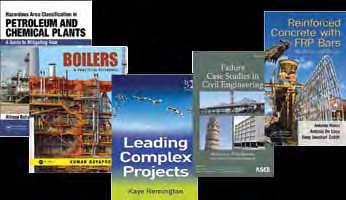
THE INSTITUTION OF ENGINEERS, MALAYSIA
Bangunan Ingenieur, Lot 60 & 62, Jalan 52/4, P.O. Box 223, Jalan Sultan, 46720 Petaling Jaya. Tel: 03-7968 4001/4002 Fax: 03-7957 7678 E-mail: lib@iem.org.my
Homepage: http//www.myiem.org.my/
E-BOOKS RECOMMENDATION FORM FOR LIBRARY ACQUISITION
I would like to recommend the following books for your consideration with the view of acquiring them for the use of the IEM members.
Title (s) of the book:
1. ............................................................................................................................................... 2. ...............................................................................................................................................
3. ...............................................................................................................................................
Author (s): .................................................................................................................................
Publisher/ISBN No. ....................................................................................................................
Price (US$RM: ...................... Year published: ......................... Edi on .....................................
Proposer: ...................................................................................................................................
Membership No./Grade: ...........................................................................................................
Tel. Number: .................................................................. Signature: .......................................
Thank You.
IEM LIBRARY
The Institution of Engineers Malaysia Tel: 03-7698 4012 Fax: 03-7957 7678 Email: lib@iem.org.my










